The mysteries and unknowns of space have always been enticing. Throughout the centuries, people have sought to unravel its secrets. With the advancement of the space industry, the exploration of the solar system and distant galaxies has reached new heights. While much remains unexplored and beyond our comprehension, the future holds endless possibilities.
In this article, we will delve into the planet Mercury, one of the celestial bodies in the solar system. You will discover fascinating details about this planet, such as the duration of its day and year, the presence of satellites and rings, and much more.
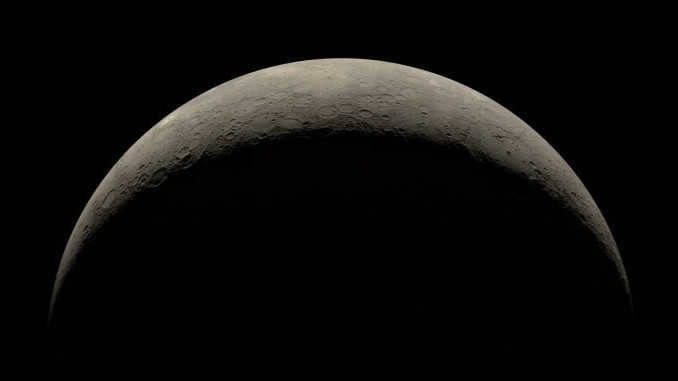
Which planet is closest to the Sun?
In the solar system, Mercury holds the distinction of being the smallest planet. Prior to 2006, Pluto held this title, but during the IAU General Assembly convention on August 24, it was decided to reclassify Pluto as a dwarf planet.
With a distance of 57,900,000 km from the Sun, Mercury is the planet that is closest to our star. Following Mercury are Venus, Earth, and Mars, and beyond the asteroid belt lie the gas giants: Jupiter, Saturn, Uranus, and Neptune. Therefore, Mercury is the first planet in the solar system in terms of proximity to the Sun.

The Color of the Celestial Body
Observations conducted by space satellites and ground-based telescopes have allowed scientists to accurately determine the color of Mercury. The entire surface of the planet is covered with gray rocks, which formed as a result of solidified molten lava. The cooling of the magma and the subsequent formation of rocky structures occurred billions of years ago. Today, Mercury is a planet made up entirely of exposed rock. Scientists have not observed any signs of erosion or tectonic activity on the planet for several million years. The landscape of Mercury only changes due to meteorite impacts, which create furrows on its surface.
According to geologists who have examined the images, there have been no active volcanoes observed on the planet closest to the Sun. It is purely speculative to imagine what color Mercury would be if it were covered in hot magma flows. However, as of today, it appears to us as a featureless gray planet.

Exploration of the Terrain
The Messenger spacecraft collected a vast amount of high-quality images of Mercury’s surface, which were provided to scientists for analysis. These images provide a clear depiction of the planet’s color, showcasing a dominant palette of dark gray shades.
Utilizing satellite technology, these images possess exceptional resolution. Upon examination, scientists have discovered the presence of light-colored depressions on Mercury’s surface, indicating recent geological changes. This suggests that the planet’s landscape has undergone minor transformations within a short span of time.
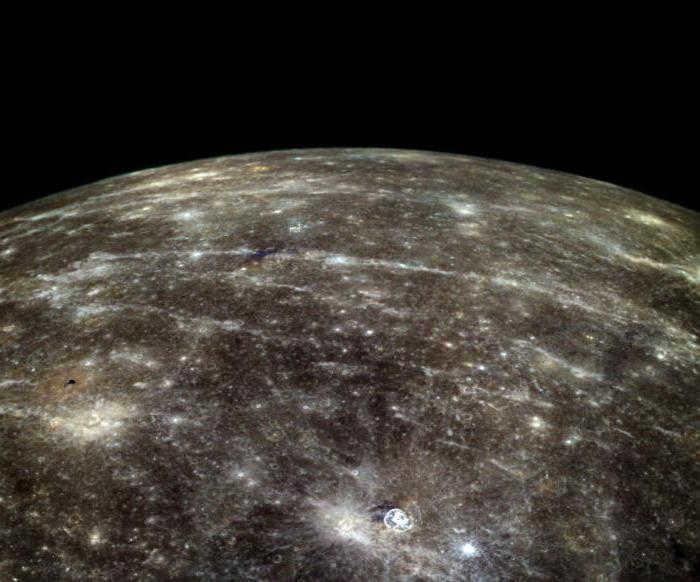
It is easy to determine the color of Mercury by examining a photograph of the planet. Its appearance closely resembles that of the Moon, with both celestial bodies sharing similar coloring and landscapes. Comparing photographs of Mercury and the Moon reveals that their surface coloring is predominantly gray, and both exhibit visible craters from meteorite impacts. However, there are also notable differences between them. For instance, Mercury features numerous escarpments that are absent on the Moon. Conversely, lunar seas, a characteristic of the Moon, cannot be found on the first planet from the Sun.
Curious facts
Thanks to the progress of the space industry, humanity has been given the remarkable opportunity to gain a deeper understanding of our vast universe, including the various planets that make up our solar system. Let’s delve into some intriguing details about the planet Mercury:
- A single day on Mercury spans approximately 59 Earth days, signifying the duration it takes for the planet to complete one rotation around its own axis.
- In its orbit around the Sun, Mercury completes a full circle in merely 88 Earth days, serving as the length of a year on this peculiar planet.
- Mercury experiences substantial temperature fluctuations. During nighttime, the planet’s surface cools down to a chilling -183 degrees Celsius, while during the daytime, the Sun’s scorching rays raise the temperature to a staggering +430 degrees Celsius. This extreme variance in temperature is due to Mercury’s inability to effectively retain heat.
- The composition of Mercury’s exosphere, which is a type of atmosphere, changes depending on its distance from the Sun. Sodium, calcium, and magnesium have been discovered by scientists in its exosphere. The concentration of these substances varies as we approach or move away from the Sun.
- Despite its difficulty to spot in the sky, our ancestors were aware of Mercury’s existence thousands of years ago.
- Venus and Mercury are the only two planets in the solar system that lack natural satellites or rings.
- Mercury is known for having the largest reserves of sulfur. Additionally, water ice and organic materials have been detected on the planet.
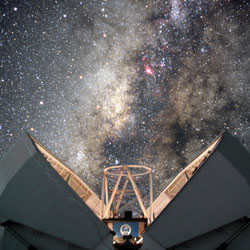

Science
The vast expanse of outer space is brimming with unexpected wonders and breathtaking landscapes that today’s astronomers have the ability to capture on film. On occasion, spacecraft or ground-based telescopes take such peculiar photographs that scientists are left puzzling over their nature for extended periods of time.
Space photography has facilitated the discovery of awe-inspiring phenomena. By examining the intricate details of planets and their moons, astronomers are able to make deductions about their physical characteristics, calculate the distance to celestial bodies, and much more.
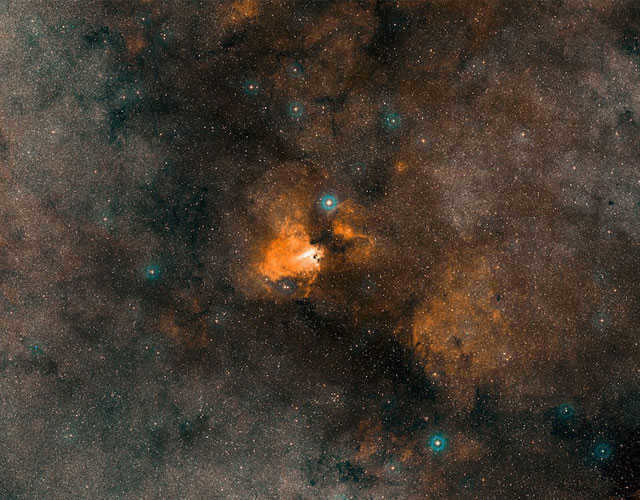
New photos of Mars
2) Mysterious protrusions on Mars. This image was captured by the panchromatic context camera aboard the Mars Reconnaissance Orbiter. The Mars Reconnaissance Orbiter is currently conducting exploration missions on Mars.
The photo reveals peculiar formations that have developed on the surface as a result of lava flows interacting with water. The lava, flowing down the slope, encircled the bases of the hillocks before expanding. Lava expansion is a process in which a liquid layer beneath a layer of solidifying lava lifts the surface slightly, creating these distinct features.
These formations can be found in the Martian plain known as Amazonis Planitia – an extensive region covered in solidified lava. The plain is also coated with a thin layer of reddish dust, which cascades down the steep slopes and forms dark streaks.
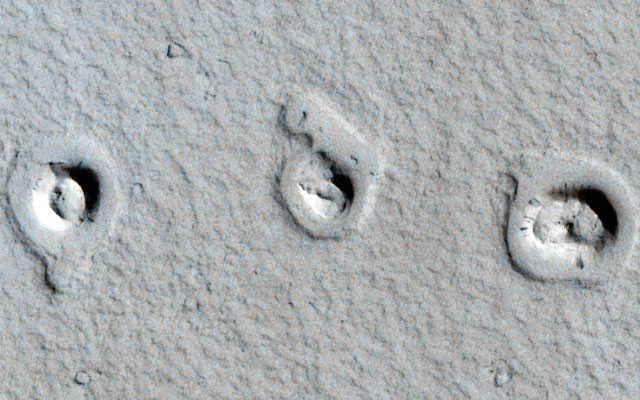
Mercury Planet (photo)
3) The stunning hues of Mercury. This vibrant image of Mercury was created by merging numerous photographs captured by NASA’s interplanetary spacecraft “Messenger” during its year-long orbit around Mercury.
Naturally, these do not represent the actual colors of the Sun’s nearest neighbor, but the vivid images showcase the chemical, mineralogical, and physical distinctions within Mercury’s terrain.
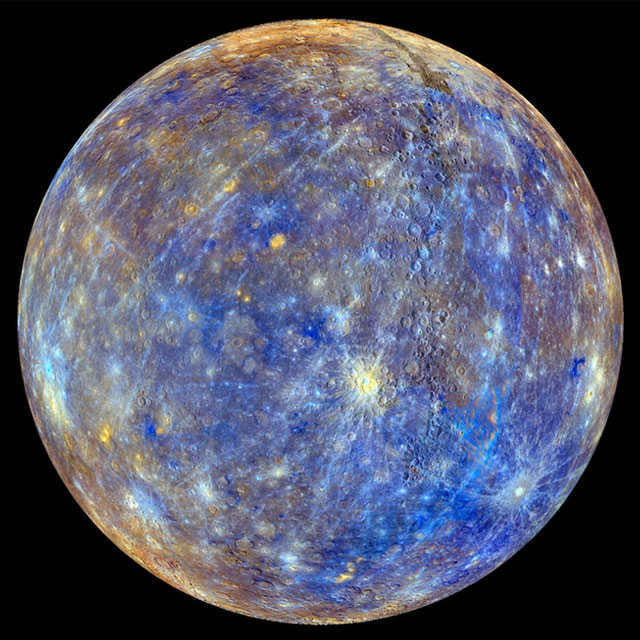
4) Space lobster. This photograph was captured by the VISTA telescope operated by the European Southern Observatory. It showcases a celestial vista featuring an expansive luminous nebula made up of gas and dust enveloping newly formed stars.
This particular infrared image showcases the NGC 6357 nebula located in the Scorpius constellation, offering a fresh perspective. The photograph was taken as a part of the ongoing Vía Láctea project, with scientists currently engaged in the comprehensive mapping of our galaxy, aiming to unravel its intricate structure and elucidate its formation process.
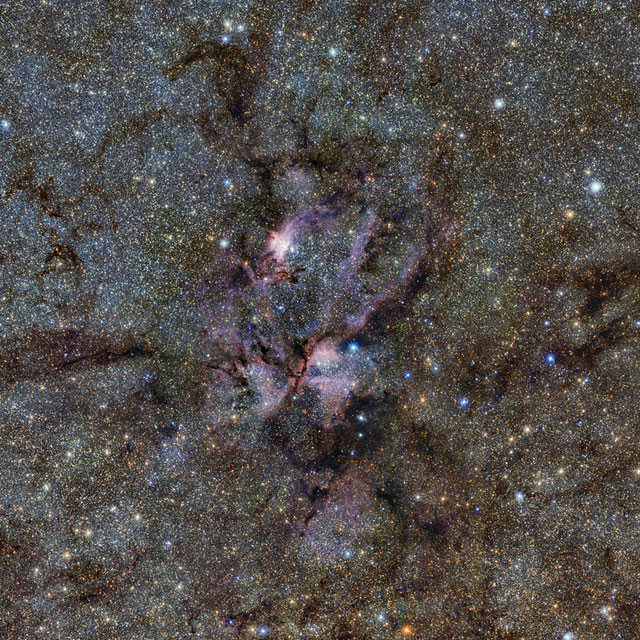
The enigmatic peak of the Kiel Nebula
5) Enigmatic peak. This captivating snapshot showcases a peak composed of cosmic dust and gas emerging from the depths of the Kiel Nebula. The pinnacle of this vertical formation, standing at an astonishing height of approximately 3 light-years, is gracefully influenced by the radiant energy emanating from celestial bodies in its proximity. In fact, stars in close vicinity to these majestic structures emit streams of gaseous matter, which are visibly discernible at their summits.
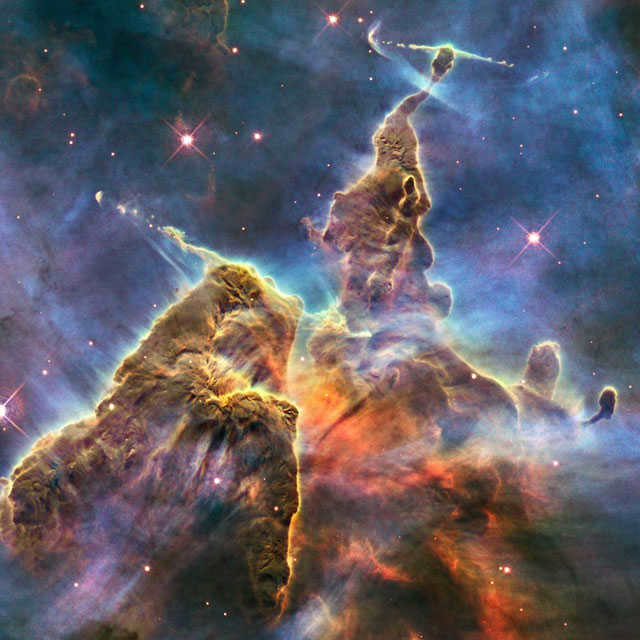
Discovering Evidence of Water on Mars
6) Uncovering evidence of the existence of water on Mars. This captivating photograph was captured on January 13, 2013 by the esteemed Mars Express spacecraft of the European Space Agency. Providing an authentic depiction of the Martian landscape, the image captures the region southeast of Amenthes Planum and north of Hesperia Planum.
The remarkable image showcases impact craters, volcanic channels, and a valley where it is believed liquid water may have once flowed. These geological features are adorned with dark sediments, likely transported by the wind.
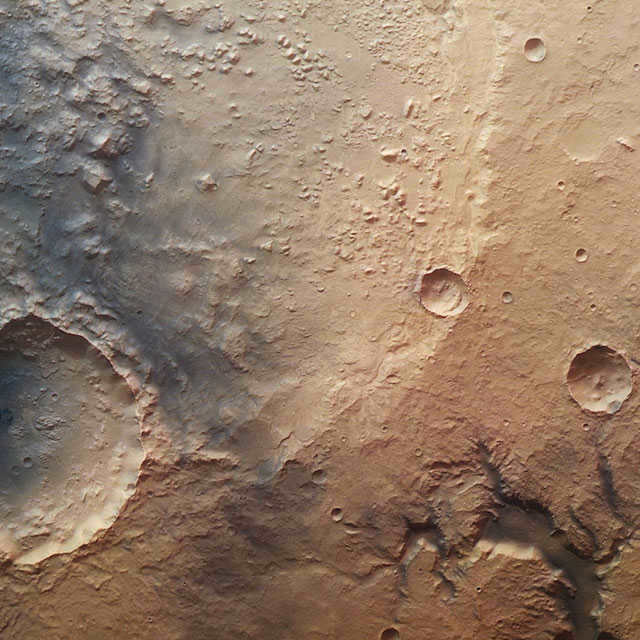
7) An enigmatic space gecko. This astonishing photograph was captured by the renowned MPG/ESO 2.2-meter telescope at the prestigious European Southern Observatory in Chile. The captivating image showcases a luminous star cluster known as NGC 6520, accompanied by its peculiar companion – a mysteriously contoured dark cloud named Barnard 86.
Immersed within the vibrant heart of the Milky Way, this extraordinary celestial duo is encircled by countless shimmering stars. The surrounding cosmos is so densely populated with these radiant celestial bodies that the profound darkness of the sky becomes scarcely visible.
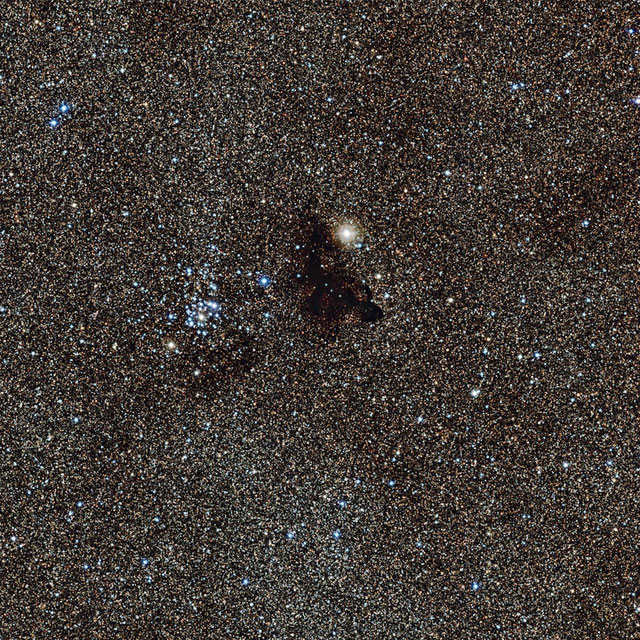
Formation of Stars (Image)
8) Center of Star Formation. NASA’s space telescope “Spitzer” captured an infrared image depicting several generations of stars. The region, referred to as W5, is filled with smoke-like matter where new stars are currently being formed.
The more mature stars are represented as brilliant blue dots, while the younger stars emit a pinkish hue. The brighter areas within the image indicate the locations where new stars are in the process of forming. The color red signifies heated dust, whereas green represents dense clusters of clouds.
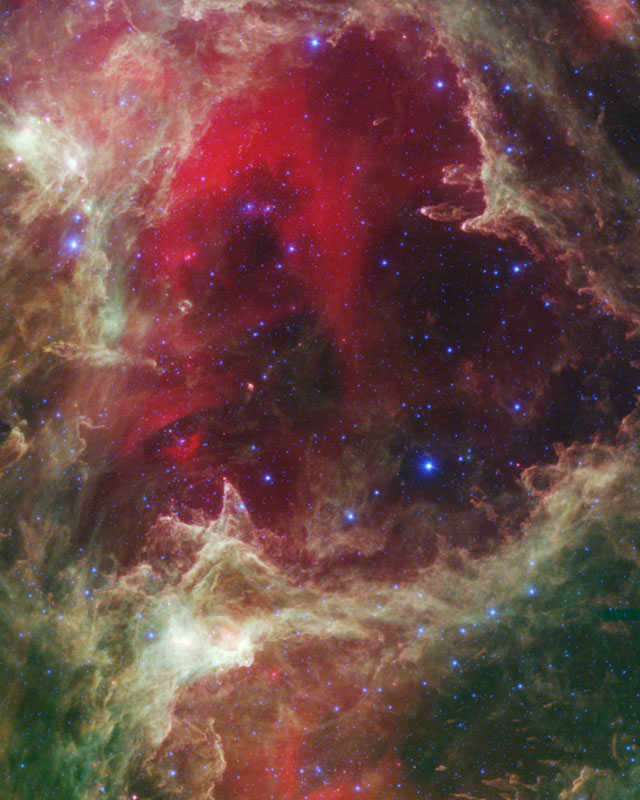
Uncommon celestial cloud (picture)
9) The nebula of Valentine’s Day. This is an image of a cosmic cloud that might evoke thoughts of a blooming rose and was captured using a telescope located at the Kitt Peak National Observatory in the United States.
Sh2-174 – is an extraordinary ancient celestial cloud. It originated from the explosion of a small-star towards the end of its lifespan. What remains of the star is its core, a white dwarf.
Typically, white dwarfs are positioned very close to the core, but in the case of this cloud, its white dwarf is situated to the right. This asymmetry is a result of the interaction between the cloud and its surrounding environment.
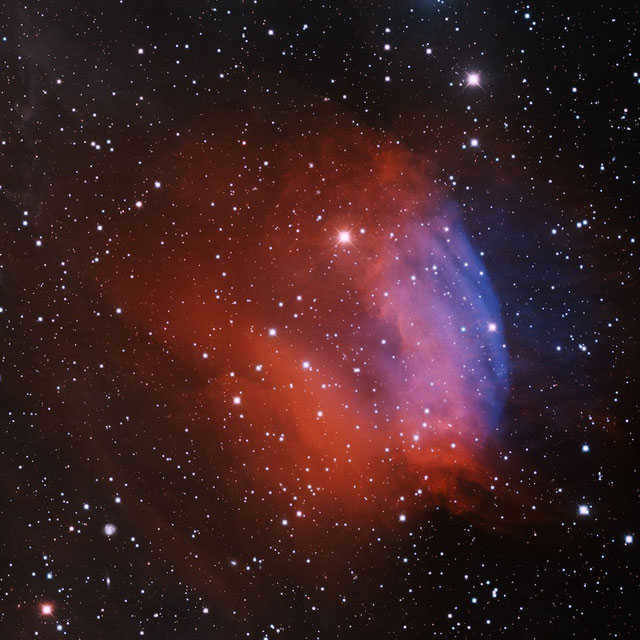
10) The Sun’s Heart. In celebration of Valentine’s Day, which has just passed, another extraordinary occurrence graced the sky. To be precise, a photograph captured an image of an extraordinary solar flare that took the form of a heart.
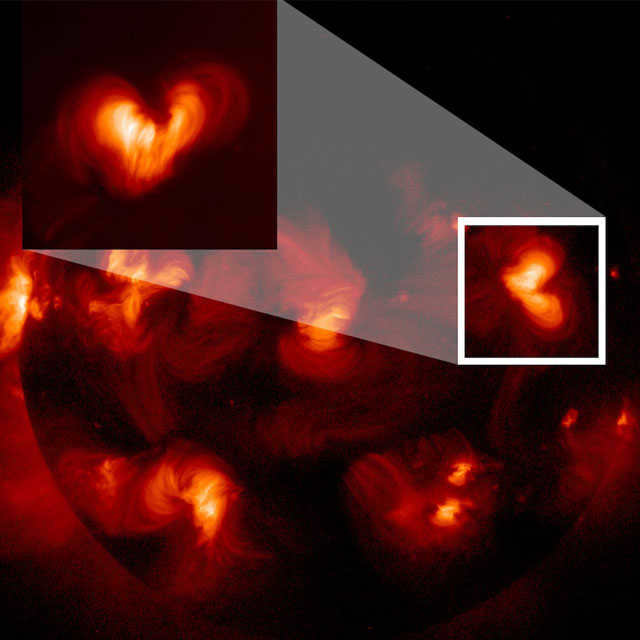
Saturn’s moon (photo)
11) Mimas, known as the Death Star. NASA’s Cassini spacecraft captured this image of Saturn’s moon Mimas during its closest approach to the celestial body. This moon bears a striking resemblance to the Death Star, the iconic space station from the Star Wars saga.
The Herschel Crater has a diameter of 130 kilometers and dominates the right side of the moon in this photograph. Scientists are actively studying this impact crater and its surrounding areas.
These photos were taken on February 13, 2010 from a distance of 9,500 kilometers and were then combined into a single, clearer, and more detailed image.
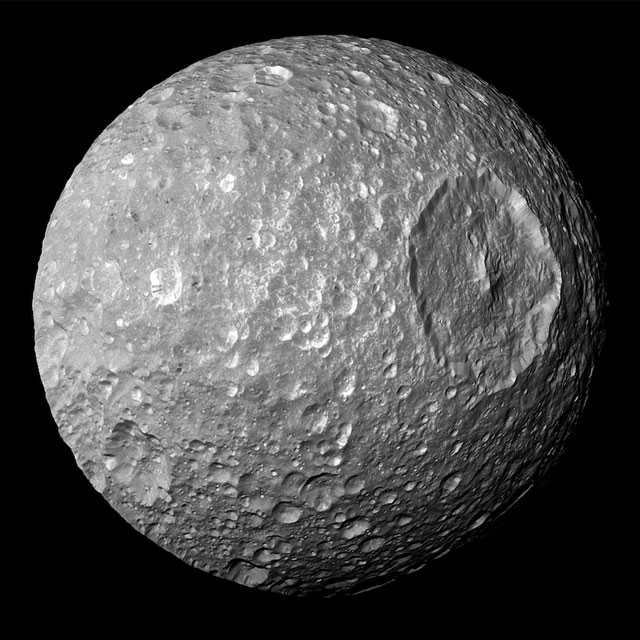
12) A cosmic pair. These two galaxies, captured in the same image, exhibit distinct shapes. The first galaxy, known as NGC 2964, displays a symmetrical spiral structure, while the second galaxy, NGC 2968 (located in the top right corner), is experiencing a close interaction with a smaller neighboring galaxy.
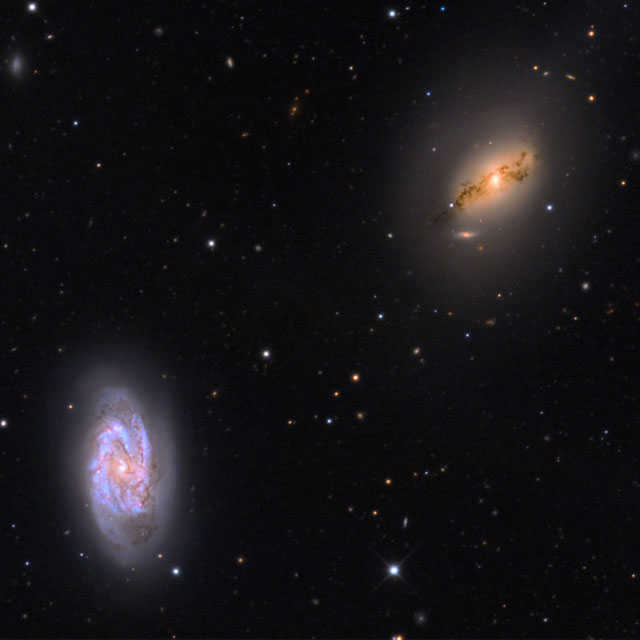
13) The colorful crater of Mercury. Although Mercury does not have a vibrant surface, there are certain areas that exhibit contrasting colors. These images were captured by the “Messenger” spacecraft during its mission.
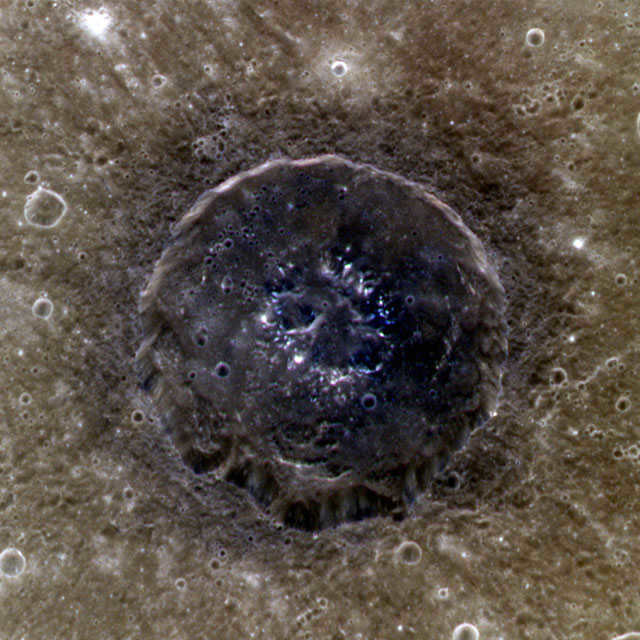
Photo of Halley’s Comet
14) A captured moment of Halley’s Comet in 1986. This iconic image of the comet’s final approach to Earth was captured 27 years ago.. The photo vividly depicts the illumination of the Milky Way on the right side by the passing comet.
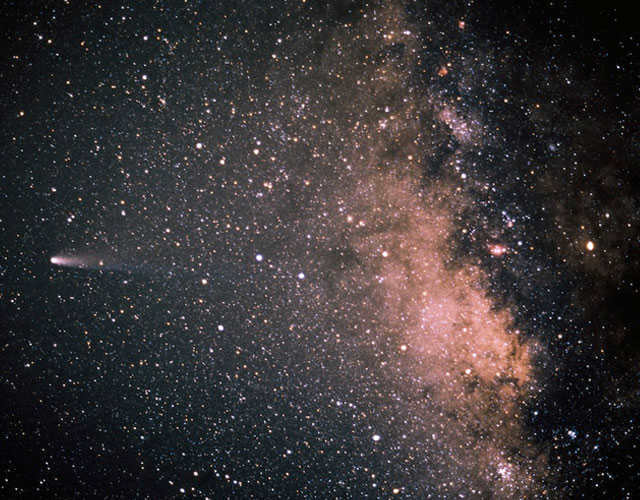
15) An unusual mound discovered on Mars. This photograph unveils an intriguing pointed structure located in close proximity to the South Pole of the Red Planet. The mound’s exterior exhibits distinct layers and noticeable signs of wear and tear. Experts estimate its towering height to range between 20 and 30 meters.. The presence of dark blemishes and streaks on the mound can be attributed to the annual thawing of a layer of frozen carbon dioxide (dry ice).
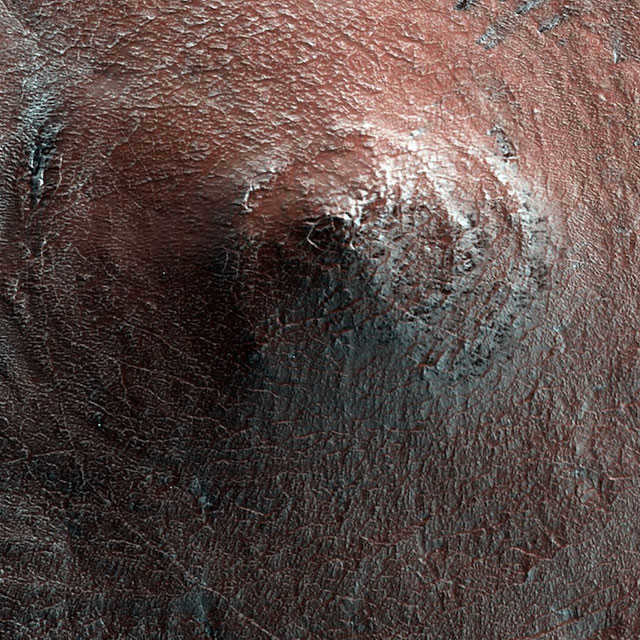
Photo of the Orion Nebula
16) The stunning veil of Orion. This remarkable image showcases the celestial clouds and stellar wind surrounding the star LL Orionis, which interacts with the nebula of Orion. The wind produced by LL Orionis is more powerful than that of our own middle-aged star, the Sun.
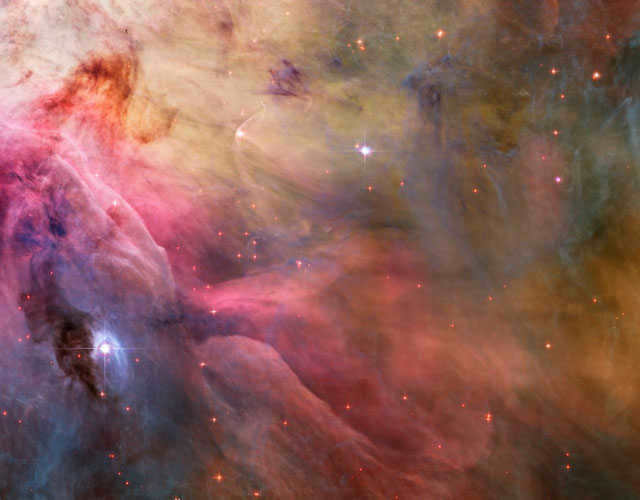
Galaxy in the constellation Canes Venatici (photo)
17) Messier 106 spiral galaxy in the constellation Canes Venatici. NASA’s space telescope, the “Hubble Space Telescope”, captured one of the most impressive images of this spiral galaxy with the assistance of an amateur astronomer. Messier 106.
Situated approximately 20 million light-years away, which is relatively close in cosmic terms, it stands as one of the most luminous galaxies and also one of the nearest to our own.
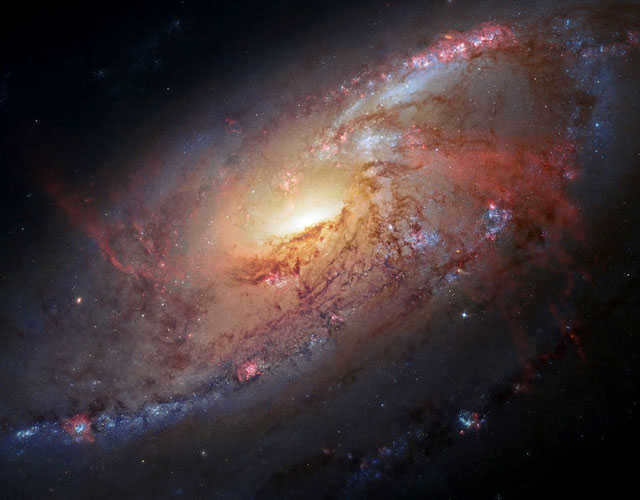
18) An extragalactic region experiencing a surge in stellar production. The celestial body known as Messier 82, colloquially referred to as the Cigar Galaxy, can be found approximately 12 million light years away in the Ursa Major constellation. It is currently in a phase of galaxy evolution characterized by a relatively rapid generation of novel stars, as determined by scientific experts.
Due to the vigorous star formation activity occurring within the Cigar Galaxy, its luminosity surpasses that of our own Milky Way by a factor of five. This captivating image was captured by the renowned Mount Lemmon Observatory, after an extensive 28-hour-long endeavor.
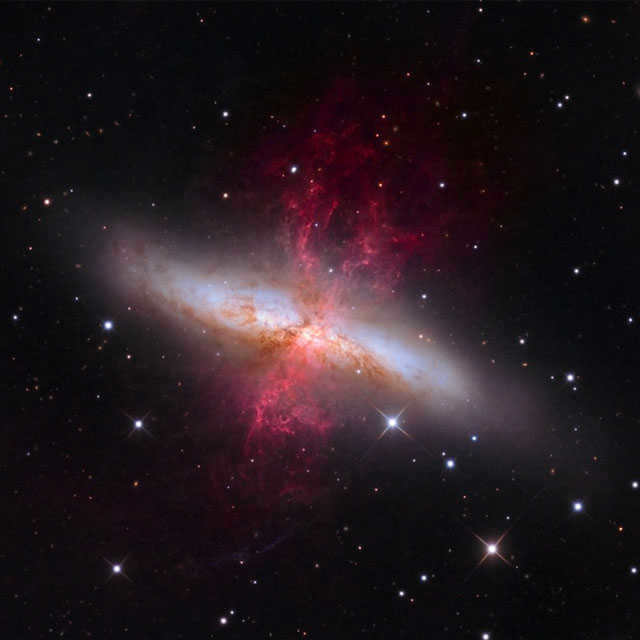
19) The Ghost Nebula. This photo was captured using the 4-meter Mayall telescope at Kitt Peak National Observatory in Arizona, USA. The celestial object known as vdB 141 is a reflection nebula situated in the constellation Cepheus.
Within the vicinity of the nebula, multiple stars are visible. Their luminosity contributes to the nebula’s slightly unpleasant yellowish-brown hue. The photograph was taken on August 28, 2009.
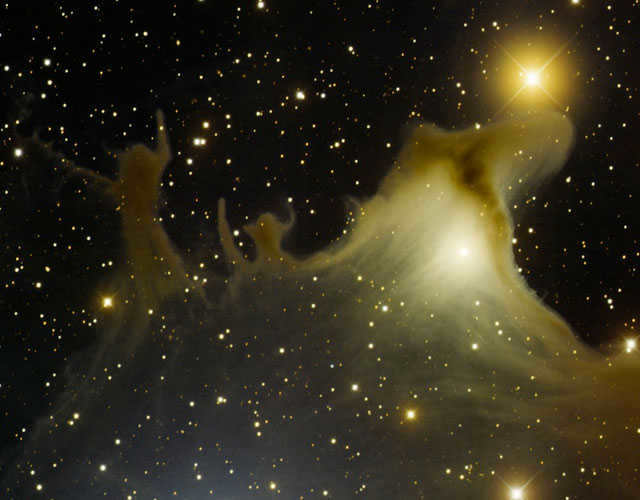
20) A mighty hurricane on Saturn. This vibrant photograph was captured by the Cassini spacecraft of NASA. "Cassini.This captivating image was taken by NASA’s Cassini spacecraft and showcases a fierce storm in the northern region of Saturn, reaching its peak intensity during that time. The image’s contrast has been enhanced to highlight the turbulent areas (depicted in white) that stand out amidst the other intricate details. The date of this photograph is March 6, 2011.
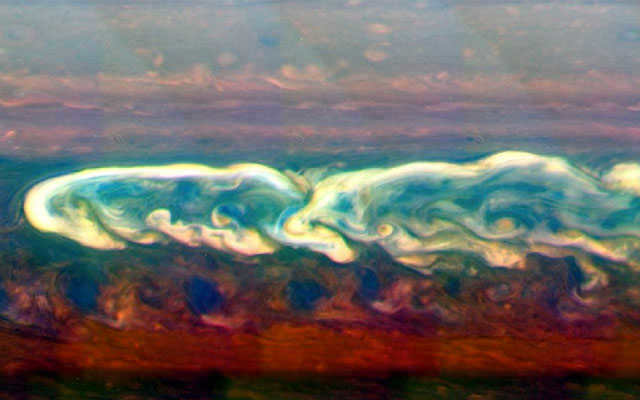
Photograph of Earth taken from the Moon
21) Earth as seen from the Moon. When standing on the lunar surface, our planet would appear like this. From this perspective, the Earth would also display phases, with certain regions in darkness and others illuminated by sunlight.
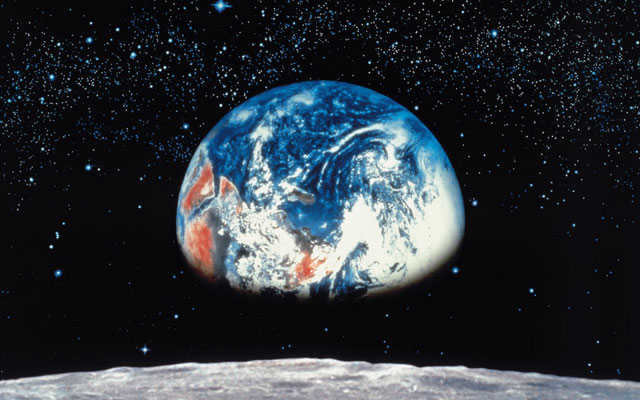
The Andromeda Galaxy
22) Fresh pictures of Andromeda. An updated image of the Andromeda galaxy captured by the Herschel Space Observatory from the Herschel Space Observatory., the vibrant streaks where novel stars are being formed can be observed in specific detail.
The Andromeda Galaxy, also known as M31. Our Milky Way’s nearest large neighbor.. It is positioned roughly 2.5 million years away and thus serves as a prime subject for researching the birth of new stars and the advancement of galaxies.
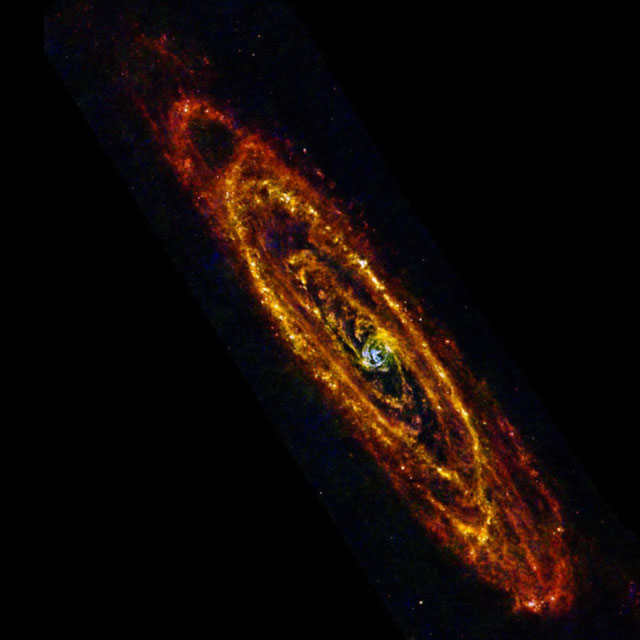
23) The birthplace of stars in the Unicorn constellation.. This stunning picture was captured on January 11, 2012, using the powerful 4-meter telescope at the Cerro Tololo Inter-American Observatory located in Chile. The image showcases a portion of the Unicorn R2 molecular cloud, which is a hotbed for the formation of new stars. Particularly notable is the vibrant red nebula region situated just below the center of the photograph.
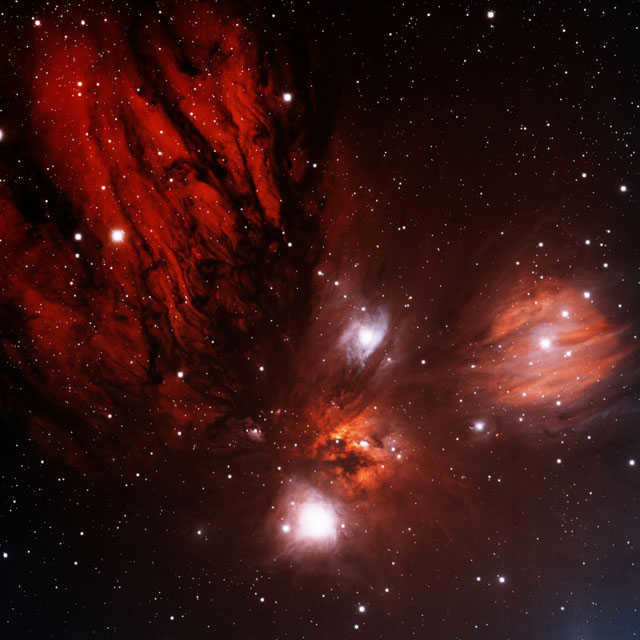
Photo of Uranus’ Partner
24) The Marked Visage of Ariel. This composite image of Ariel, Uranus’ partner, is created from a compilation of four distinct images captured by the interplanetary probe “Voyager 2”. The images were taken on January 24, 1986, while the spacecraft was positioned approximately 130,000 kilometers away from the celestial body.
Ariel boasts a diameter of approximately 1,200 kilometers and its surface is predominantly adorned with craters ranging in size from 5 to 10 kilometers in diameter. The image also reveals the presence of valleys and elongated faults, resulting in a diverse and varied landscape across the object.
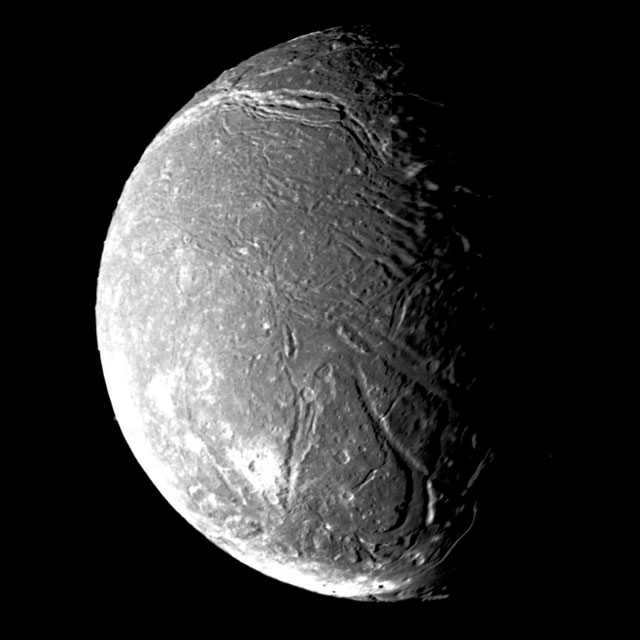
25) Spring “enthusiasts” on Mars. During the winter at high latitudes, carbon dioxide condenses out of the atmosphere of Mars and gathers on its surface, creating the seasonal polar ice caps. When spring arrives, the sun starts to heat the surface more intensely, and this heat penetrates through the transparent layers of dry ice, warming the ground underneath.
The dry ice vaporizes, instantly transitioning into a gas without going through the liquid phase. If the pressure is sufficiently high, the ice fractures and the gas escapes through the fissures. This leads to the formation of “enthusiasts.” These dark “enthusiasts” are small fragments of material that are carried away by the escaping gas.
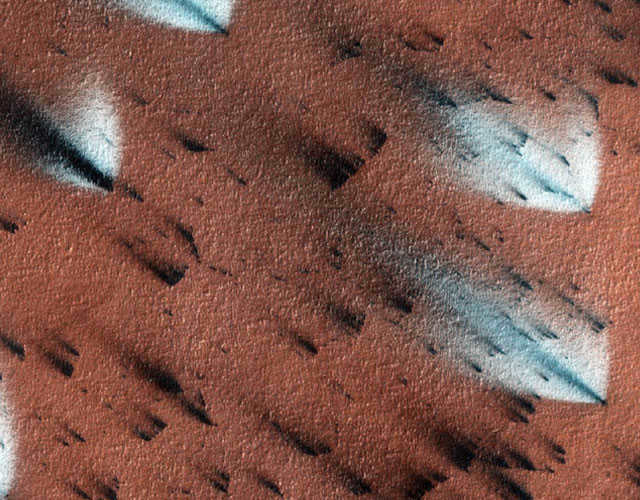
A cosmic collision
26) The Stefan Quintet.. This cluster of 5 galaxies in the Pegasus constellation is situated 280 million light years distant from our planet. It is located 280 million light years away. Four out of the five galaxies are currently undergoing a turbulent merging phase, as they gravitationally interact and eventually combine into a single galaxy.
The central azure galaxy appears to be a part of this group, but this is merely an optical illusion. In reality, this galaxy is much closer to us, only 40 million light years away. just 40 million light years away. This photograph was captured by scientists at the Mount Lemmon Observatory. (IN THE UNITED STATES.)
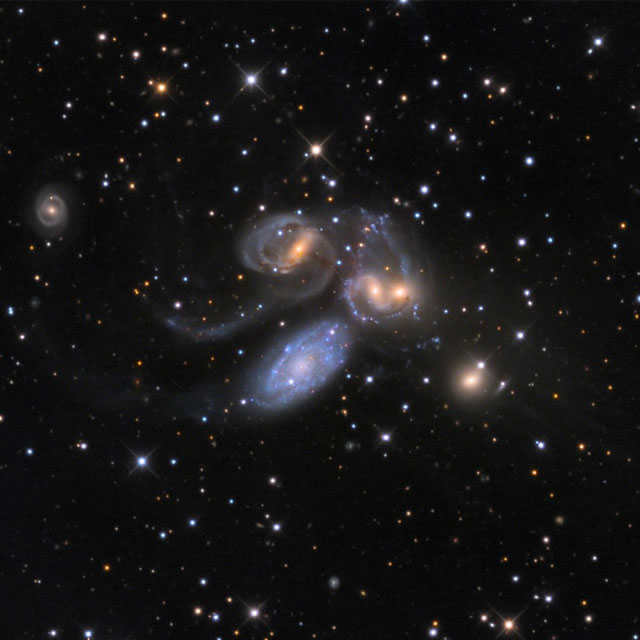
27) The Soap Bubble Nebula was first discovered by Dave Jurasiewicz, an amateur astronomer, on July 6, 2008, in the Swan constellation. The image of this nebula was captured using the 4-meter Mayall telescope at Kitt Peak National Observatory in June 2009. This particular nebula was originally part of a larger, diffuse nebula and remained hidden from astronomers’ view for a considerable period of time.
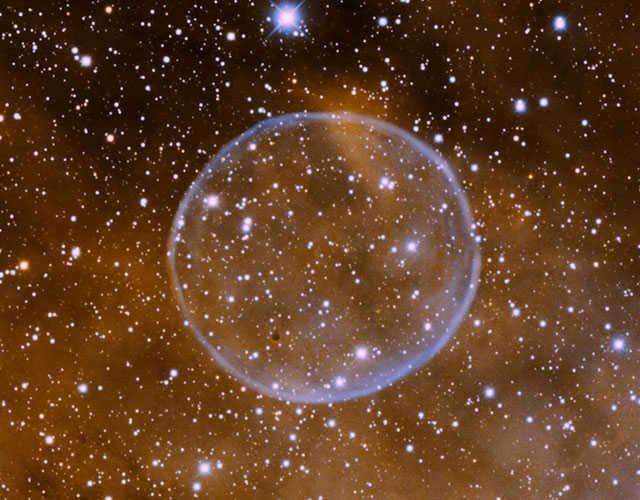
Photo of the Martian Surface at Sunset
28) Sunset on Mars. May 19, 2005 This incredible photo of the sunset was captured by NASA’s Mars rover MER-A Spirit while it was positioned on the edge of the Gusev crater. The size of the sun appears slightly smaller compared to how it appears from Earth.
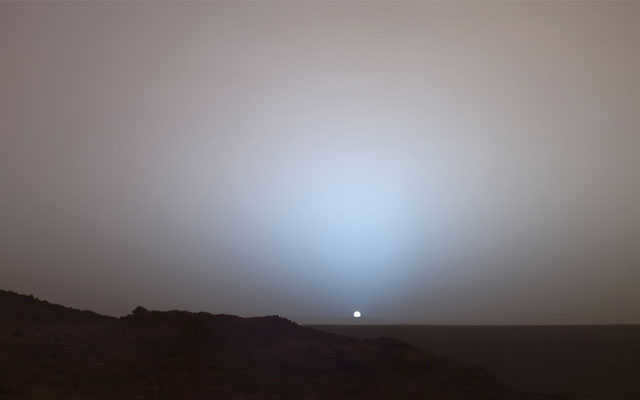
29) The hypergiant star Eta Kiel. In this remarkably detailed image captured by the Hubble Space Telescope, you can witness the vast clusters of gas and dust enveloping the colossal star known as Eta Kila. Situated over 8,000 light-years away, this celestial body boasts a structure that rivals the expanse of our own solar system.
Approximately 150 years ago, astronomers witnessed a supernova explosion emanating from Eta Kila, which at the time was the second most brilliant star, eclipsed only by Sirius. However, its luminosity rapidly diminished, making it imperceptible to the naked eye.
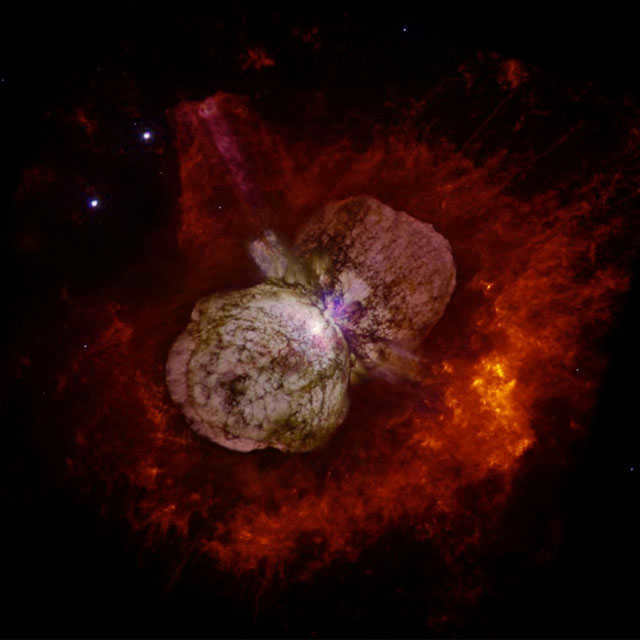
30) The galaxy with a polar ring. The extraordinary galaxy NGC 660 is formed by the combination of two distinct galaxies. It is positioned 44 million light years away from us in the Pisces constellation. On January 7, scientists revealed that a peculiar phenomenon is occurring within this galaxy, likely caused by the presence of a massive black hole at its core.
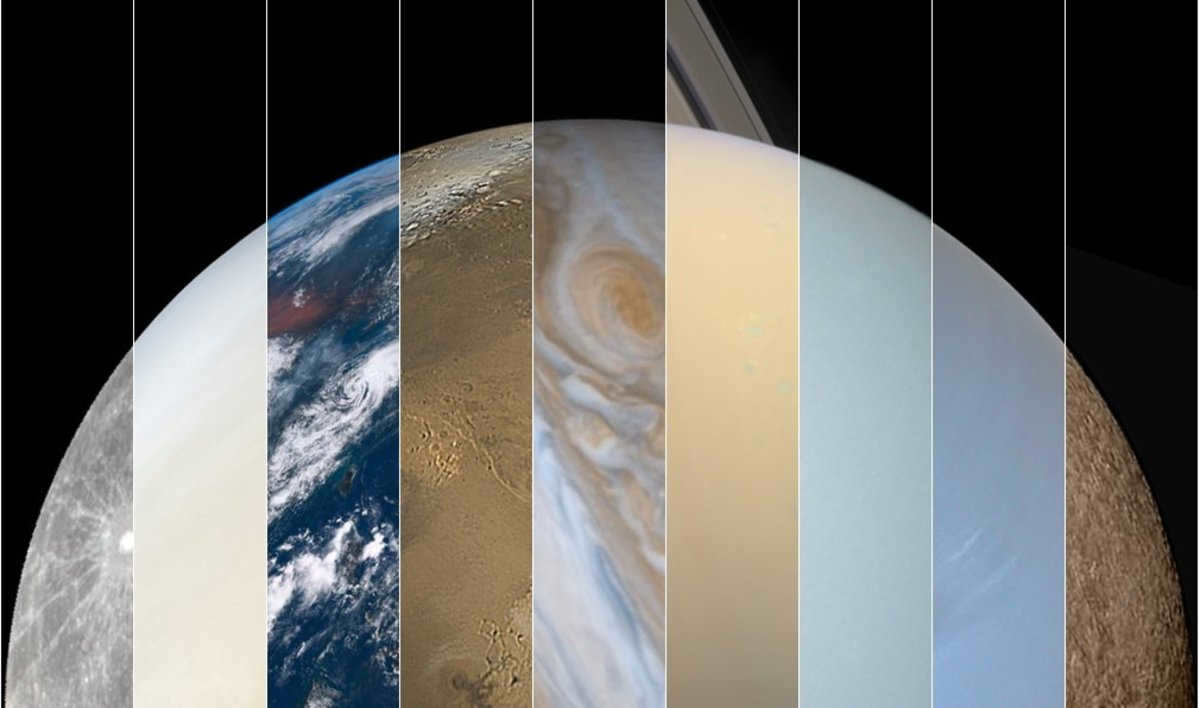
A unique collage of the solar system in true colors: Mercury, Venus, Earth, Mars, Jupiter, Saturn, Uranus, Neptune, and Pluto. (Unfortunately, high-resolution color photos of Ceres and Eridus are currently unavailable.)
My mission to create an authentic collage showcasing the nine planets
The inspiration for my photo collage above came from Stephen Gildea’s oil painting titled “Planetary Suite,” which has been widely shared on social media. However, many people have been sharing it without giving credit or realizing that it is a painting. While it is undeniably beautiful, it is not entirely accurate, especially since it was created before our exploration of Pluto.
Therefore, I took it upon myself to create a collage that portrays the planets as they truly appear. However, this task proved to be more challenging than I had anticipated. It turns out that the majority of planet photos available are not in color!
A solar system family portrait (with some artificial colors)
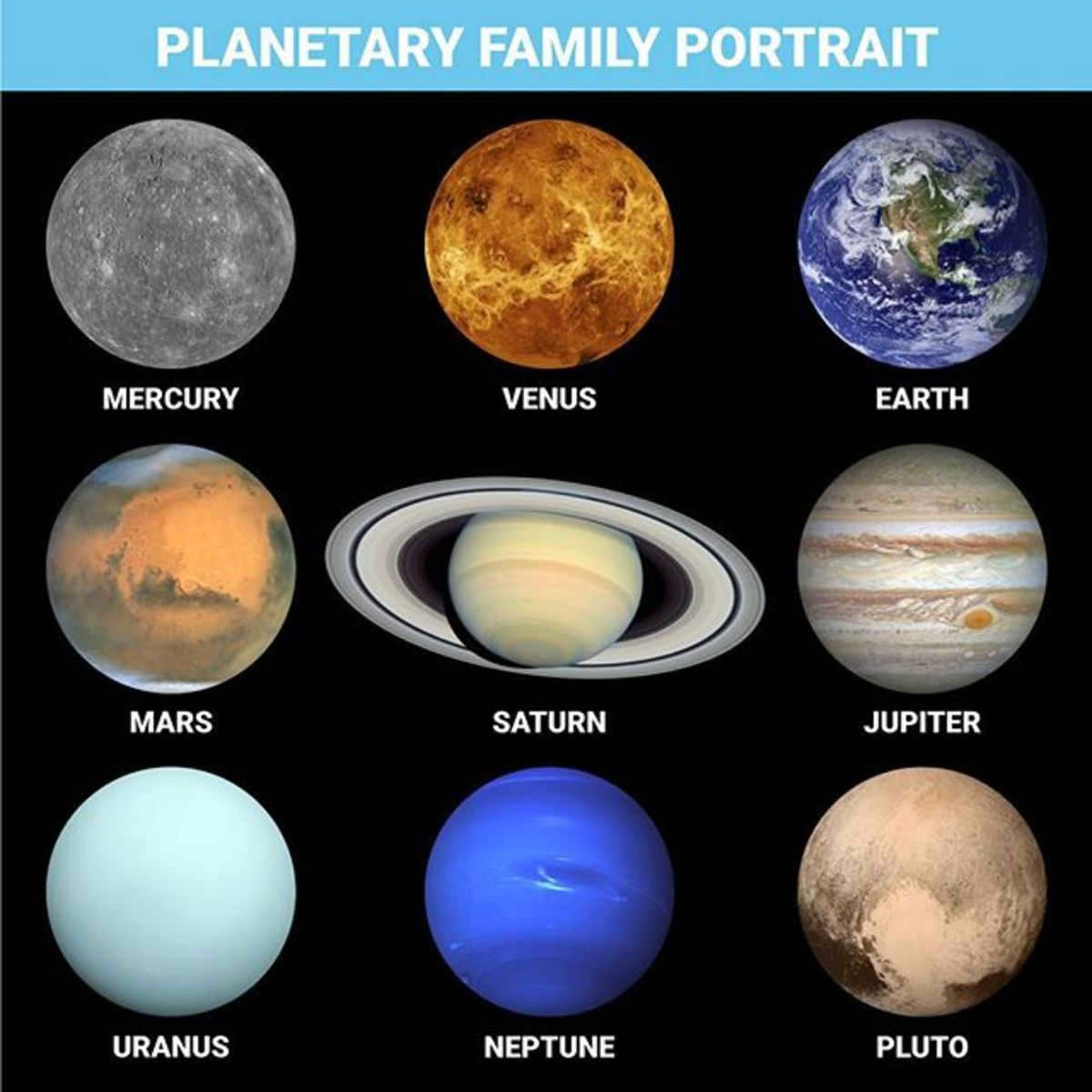
A compilation of NASA photographs depicting various planets, featuring images that have been color enhanced, artificially colored, and rendered using radar topography.
The spacecraft possesses the ability to perceive a greater range of wavelengths compared to Superman
You may have come across a compilation similar to the one showcased by Business Insider. These photographs are authentic NASA images; however, they may not accurately represent what the human eye would perceive.
Space probes and telescopes are equipped with highly sensitive cameras that are capable of detecting wavelengths beyond the visual spectrum of the human eye. This enables these instruments to capture intricate details that remain invisible to us, aiding in the differentiation of various materials such as rocks, ice, gases, and more, present on the planetary surfaces.
Most spacecraft possess the capability to detect wavelengths within the infrared and/or ultraviolet range:
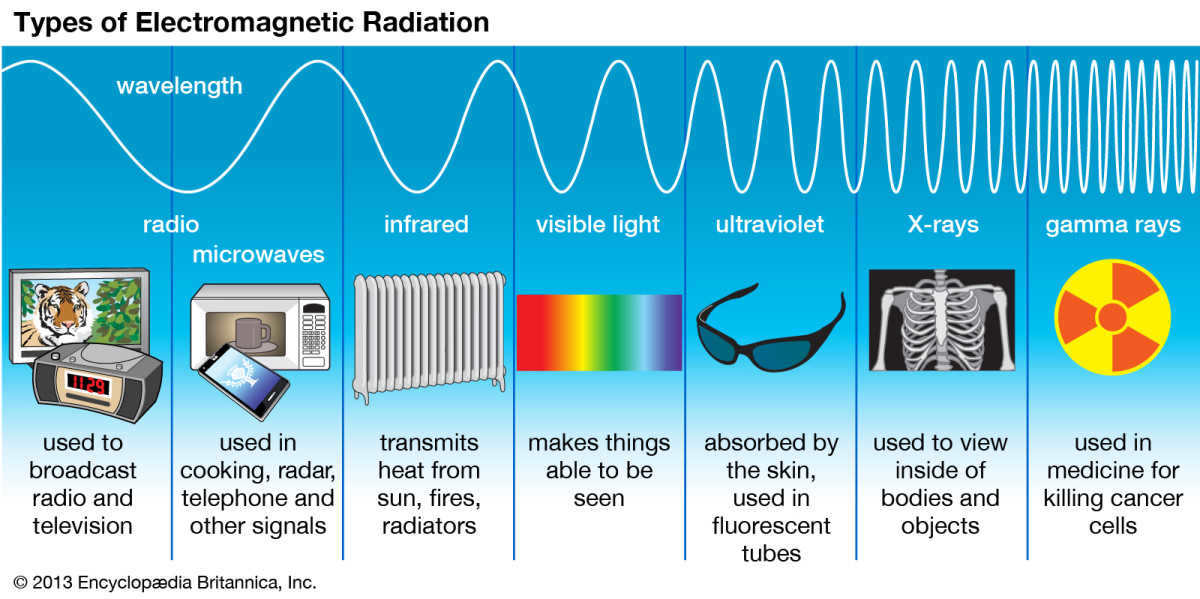
Visible light is the segment of the electromagnetic spectrum that can be detected by the human eye. Additionally, we have the ability to perceive infrared radiation as heat.
According to Britannica Internet for kids, visible light is a part of the electromagnetic spectrum that can be detected by the human eye. It also mentions that we are capable of perceiving infrared radiation as heat.
False-color images: visible light combined with infrared or ultraviolet light
In order to enhance our ability to observe hidden details, scientists are converting invisible wavelengths into colors that are visible to the human eye. This can be achieved by representing infrared and ultraviolet light with vibrant colors (located at the bottom right of the image), or by transforming the image to display colors that are already visible to the human eye (located at the bottom left of the image).
(Revised) Image of Mercury in its authentic shades and (authentic) in deceptive shades
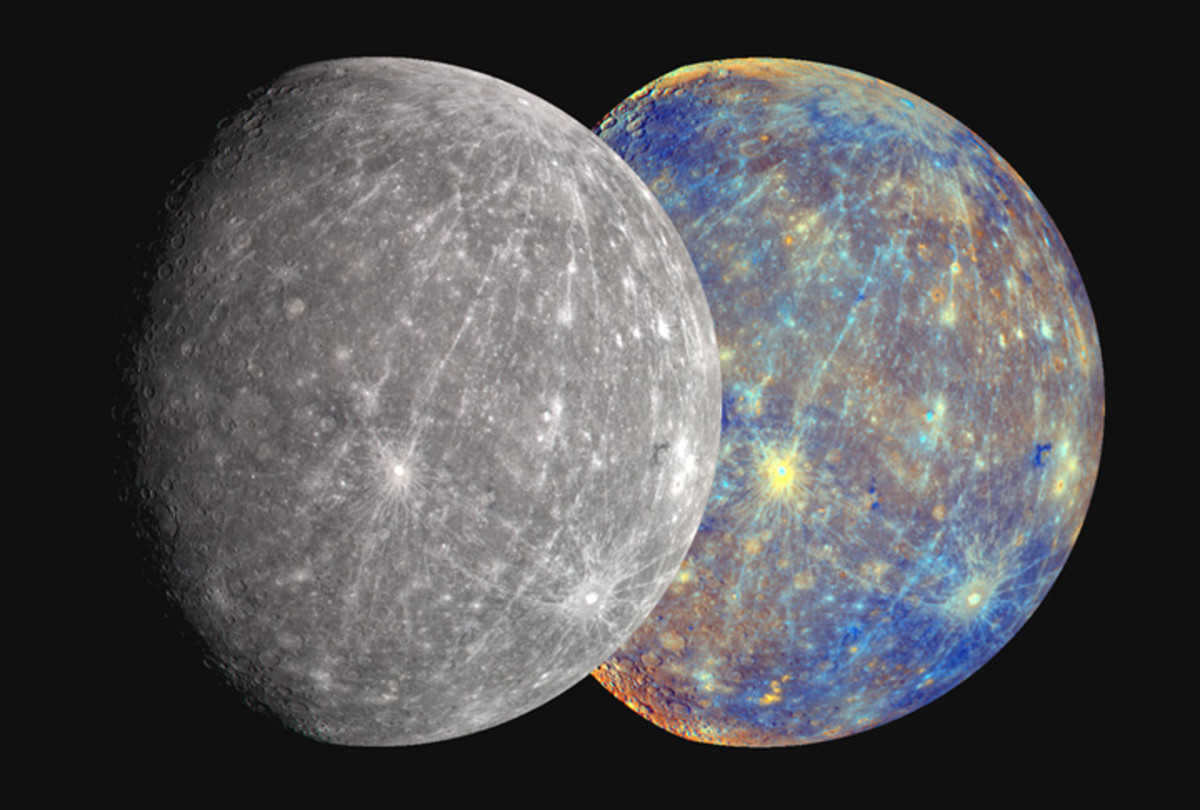
In the image on the right, the color captured by the Mercury MESSENGER spacecraft is in the visible and near-infrared spectrum. On the left, NASA scientists have adjusted the original intensity of false colors to display colors that are closer to what the human eye sees.
The spacecraft responsible for capturing these images is called NASA’s Mercury MESSENGER.
Converting Martian Light to Earth Light: The Martian Surface
The atmosphere of Mars is heavily dust-laden, resulting in photographs taken from the Martian surface bearing resemblance to those captured during a dust storm at sunset.
To address this issue, scientists employ a color calibration patch affixed to the spacecraft on missions to Mars. Having knowledge about the appearance of the patch before its departure from Earth enables researchers to adjust Mars photographs to align with Earth’s lighting conditions. This facilitates a more accurate comparison between rocks found on Mars and Earth.
Donald E. Davis, a NASA scientist involved in the Mars missions, has published an extensive article delving into the colors of Mars. In this article, he explores the intricacies of the colors depicted in photographs taken by various rovers and landing modules.

Here is a panoramic view of the Opportunity Mars rover taken in January 2015. The image shows how the landscape would appear under the lighting conditions of Earth.
This particular photo captures the Mars rover Opportunity in false color.

A picture of the Martian Opportunity rover taken in January 2015. This is what it would appear like if you were physically present.
Martian Opportunity rover (TRUE COLOR).
Ultraviolet and radar images
Venus is another celestial body that is typically captured in artificial hues. It is actually blanketed in a dense layer of nearly uniform cream-colored clouds. It resembles a precious pearl.
I have yet to witness a complete color photograph of Venus taken by any spacecraft. Instead, we receive images in artificial colors using infrared or ultraviolet radiation. For radar images, which essentially depict elevation data, the color is simulated based on surface photographs captured by Soviet landing modules.
False color and radar topography depiction of Venus
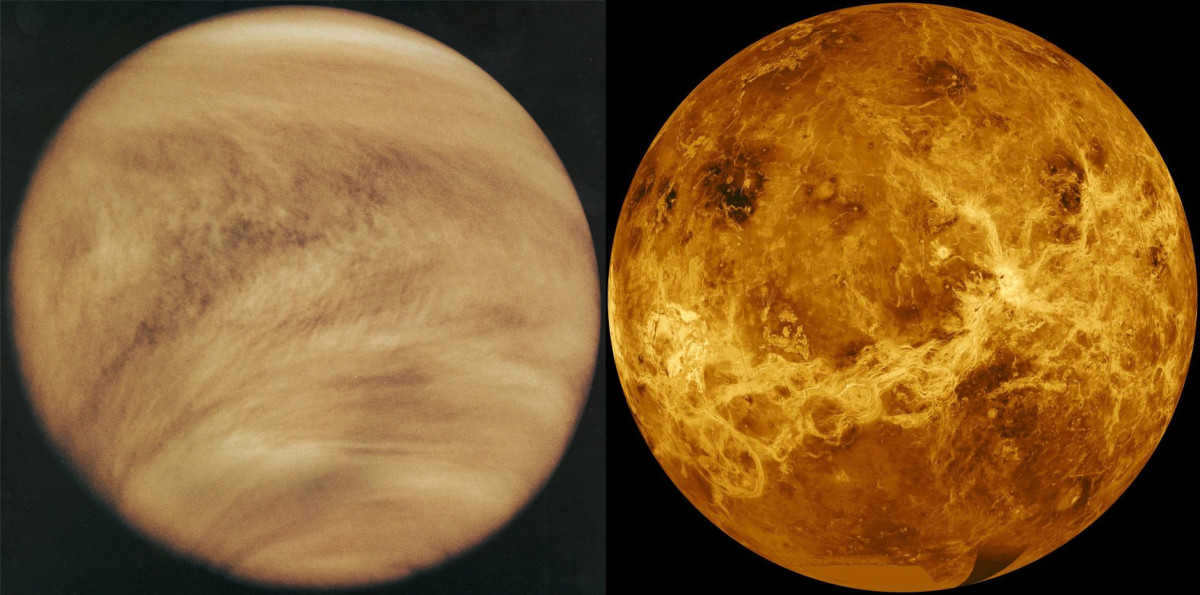
The image on the left shows Venus in ultraviolet light, captured by NASA’s Pioneer Orbiter spacecraft on February 26, 1979. On the right is a radar image of Venus, taken by NASA’s Magellan Orbiter spacecraft in the early 1990s.
The Pioneer and Magellan spacecraft were both operated by NASA.
After an extensive search, I managed to uncover the authentic hues of the photographs depicting the renowned nine planets (excluding Ceres, Erida, Haumea, and their counterparts).
Behold the images that I have procured.
Mercury MESSENGER spacecraft – October 6, 2008.
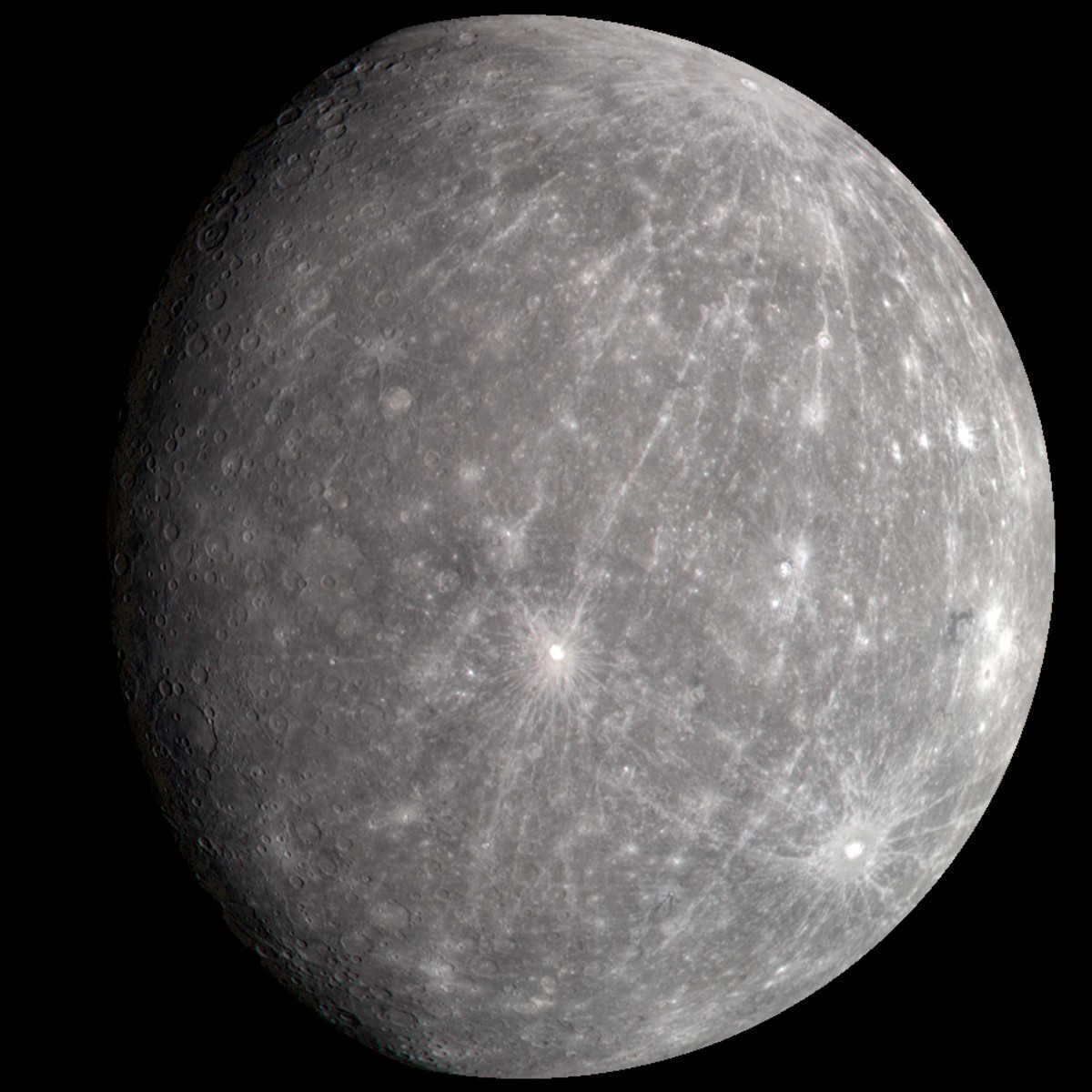
Mercury MESSENGER spacecraft, which belongs to NASA / JHUAPL / CIW, had previously conducted a survey of the planet using 11 different wavelengths. This survey included the use of near-infrared light to accurately depict the true color of Mercury.
Venus – True Color Image Rendered from False Colors, Created by Matthias Malmer
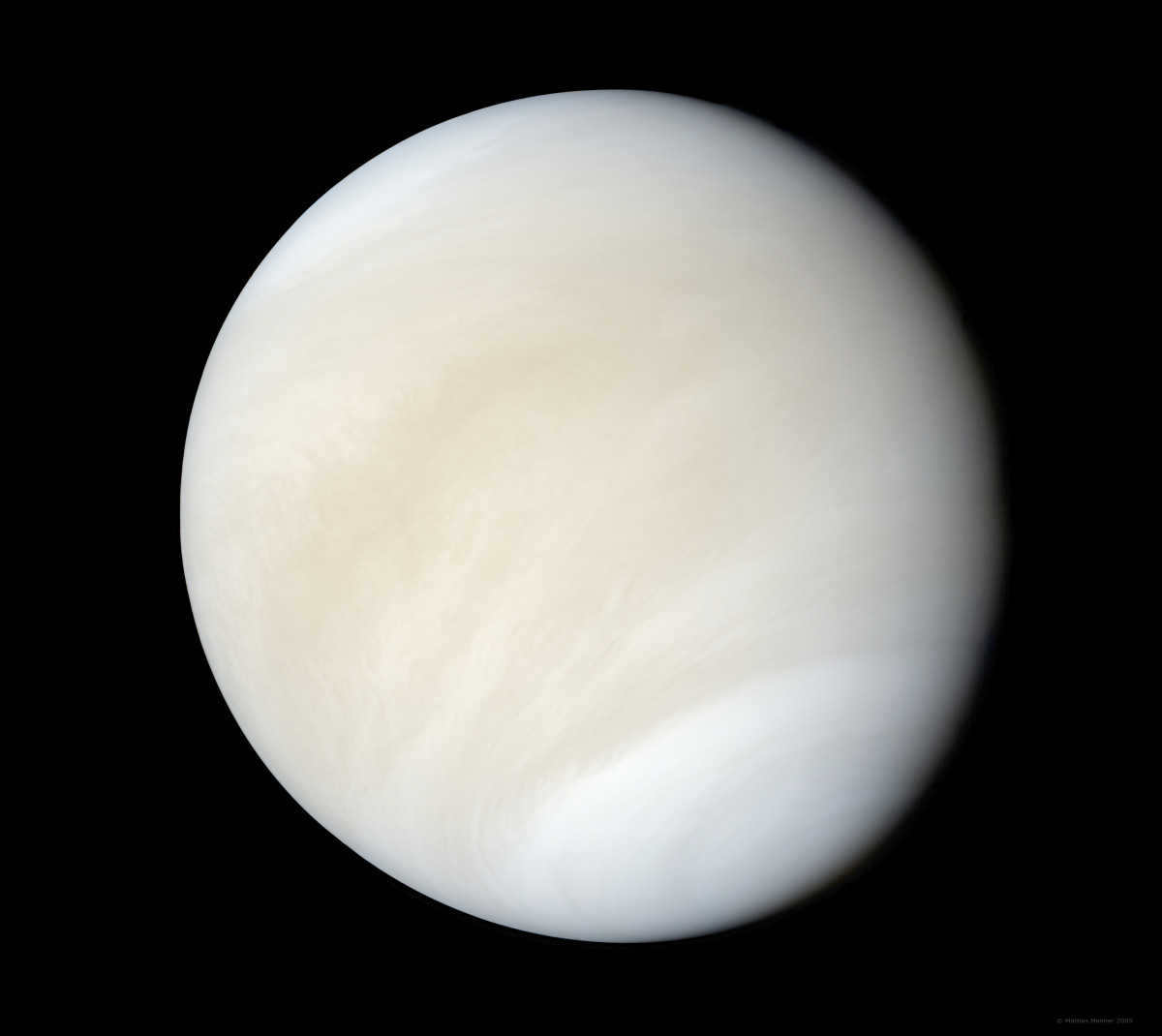
False color image of Venus from an old Mariner 10 photo, transformed into true colors using advanced image processing techniques.
The Role of the Image Processing Community in Revealing the True Colors of Venus
In recent years, a dedicated group of astrophotography enthusiasts, led by individuals such as Matthias Malmer, has been diligently scouring the extensive archives of NASA’s mission files. Their aim? To uncover hidden color data and photographs that can be combined and manipulated to produce stunning true-color images.
NASA holds great respect for the work of these talented individuals, many of whom possess professional-level photographic and astronomical expertise. In fact, it was within the pages of a NASA scientific publication that I first stumbled upon a Malmer-color corrected image of Venus.
Below, you will find a collection of additional expertly processed images showcasing both Venus and Mercury in all their colorful glory.
On August 11, 2015, the Himawari-8 spacecraft captured an image of the Earth.
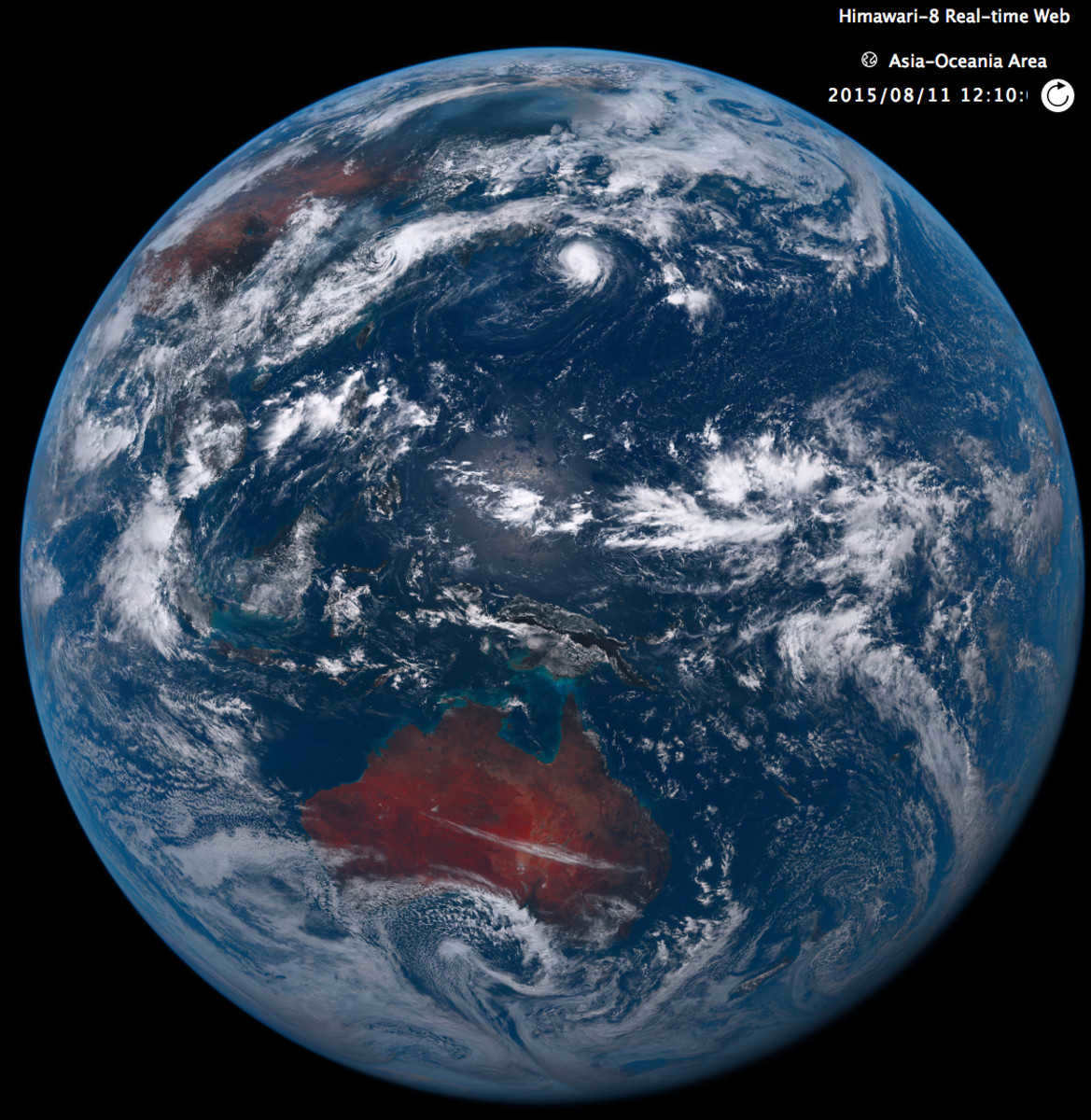
The Himawari-8 weather satellite from Japan captures a multitude of real-time images on a daily basis. Feel free to click on the link and enhance the resolution – it’s far superior to what you see here!
Himawari-8, the spacecraft responsible for these remarkable images
Real-time snapshots of Earth courtesy of Japan
The Himawari-8 weather satellite, positioned in geostationary orbit above the Pacific Ocean, produces the most high-definition color photographs I’ve ever come across. The screenshot displayed above fails to fully showcase this.
With multiple images taken each day, the resulting animations are truly awe-inspiring, as exemplified in the New York Times.
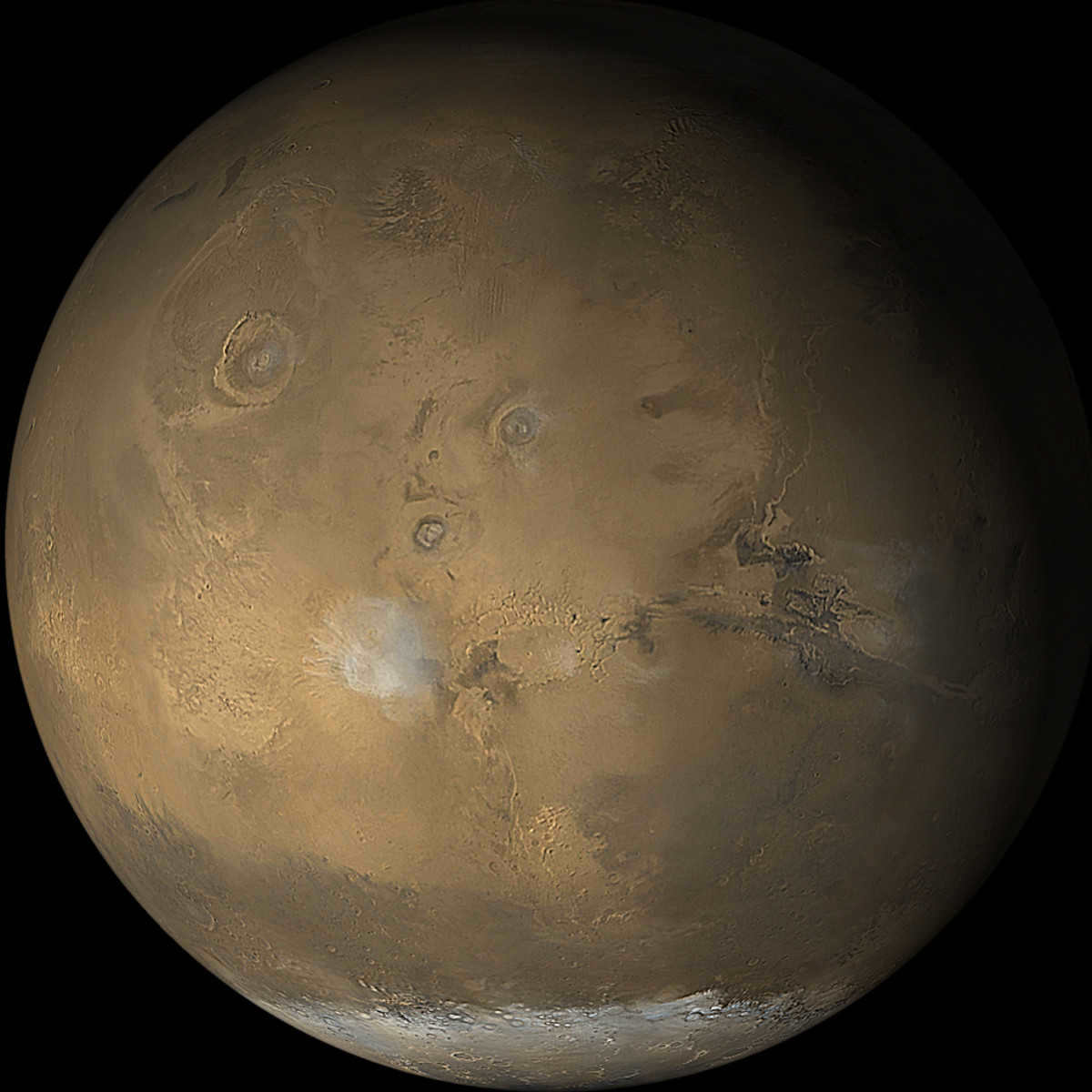
This webpage displays six different images of Mars being engulfed by a massive dust storm.
Mars Global Surveyor – NASA / JPL / Malin Space Science Systems
Even the planet Mars can be treacherous
Interestingly, my main challenge was locating a color photograph of Mars.
Firstly, Mars does not always appear the same color: it undergoes changes due to intense dust storms (Surveyor, Hubble) and/or small amounts of water ice in the atmosphere (see Comments from Planetary Scientists on this post). Secondly, we have photographs of spacecraft taken over several decades, some of which are more accurately calibrated than others. Additionally, the Hubble website occasionally uses the term “true color” in a broad sense to mean “natural color, as opposed to artificial color”.
Therefore, after examining the various images, I had to reach a conclusion:
- NASA refers to it as “true color,” a Viking photomosaic that has been projected onto an elevation map: butterscotch .
- Here is the incredibly impressive Viking photomosaic that was utilized in the top position, without the inclusion of the altitude data: butterscotch .
- An award-winning, independently reviewed map of Mars in true color, created by National Geo using data from Mars Global Surveyor: butterscotch .
- Hubble identifies this image as “true color”: brick red.
- Although not authentically true color, it has been “stretched” to emphasize details: brick red.
I made the decision to employ the Mars Global Surveyor images that were utilized by National G. This particular library is maintained and color-calibrated by Malin Space Science Systems, the company responsible for the cameras on the majority of Mars missions during the past two decades (NASA also utilized MSS to capture images of Juno for the next-generation mission to Jupiter).
May 7, 2015: Dawn spacecraft captures black and white images of Ceres
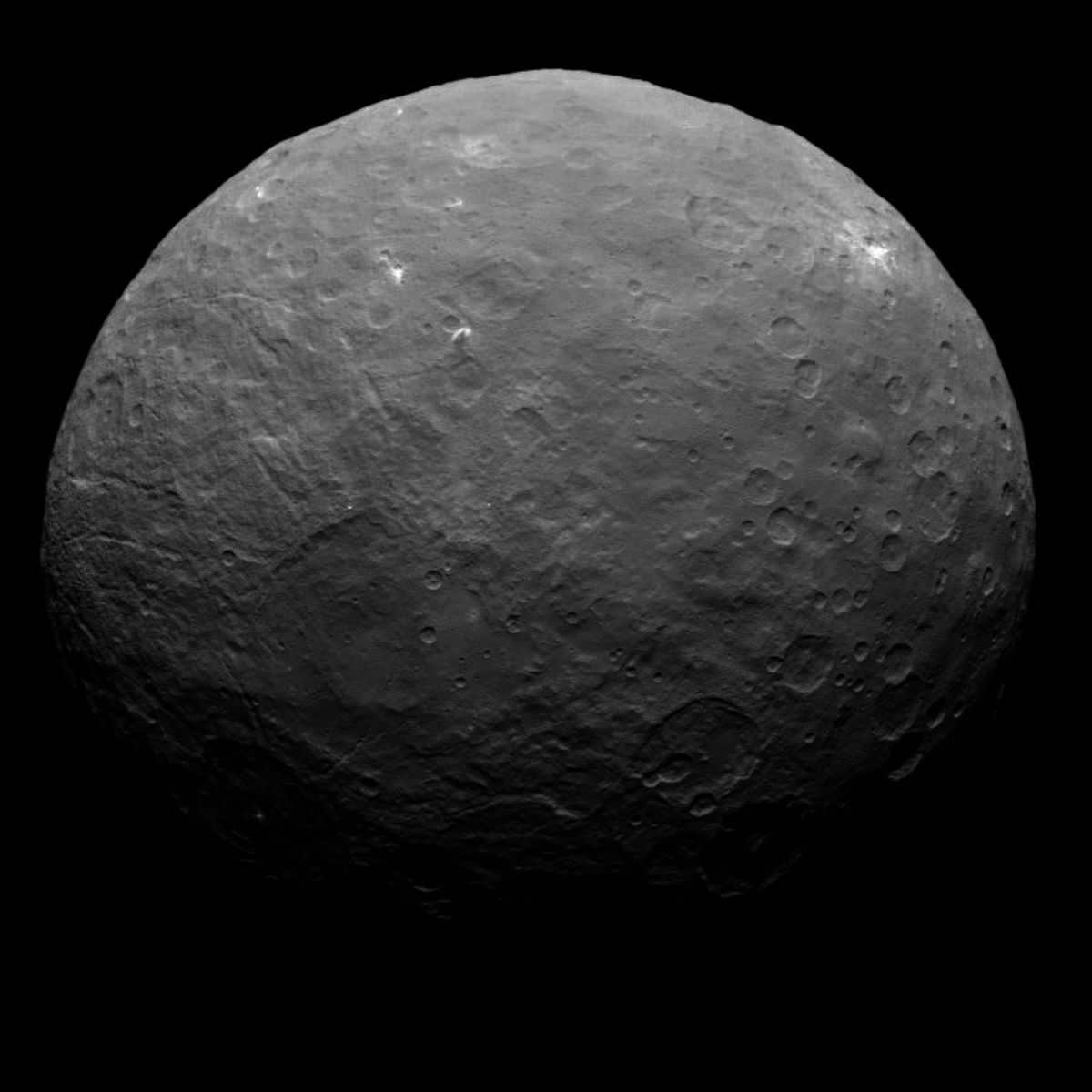
Dr. Lakdawalla has organized the photo of Ceres. I had a strong desire to feature Ceres, but I was unable to locate a Dawn image with authentic colors, and the Hubble image is inadequate in size and clarity, lacking accurate hues.
NASA / JPL / UCLA / MPS / DLR / IDA / Emily Lakdawalla
Yes, I am aware. The number of planets can be either more or less than nine.
Regarding my collage above, the discussion about “dwarf planets” is irrelevant: we won’t have detailed images of Erida or the other siblings of Pluto in the near future. I will include Ceres once the spacecraft currently in orbit begins transmitting color photographs.
Below are some color photographs of Ceres captured by the Hubble telescope. If you adjust the saturation in your mind, it might be accurate.
Jupiter – Cassini spacecraft – December 29, 2000.
The Cassini spacecraft provided a rare opportunity to study Jupiter up close on December 29, 2000.
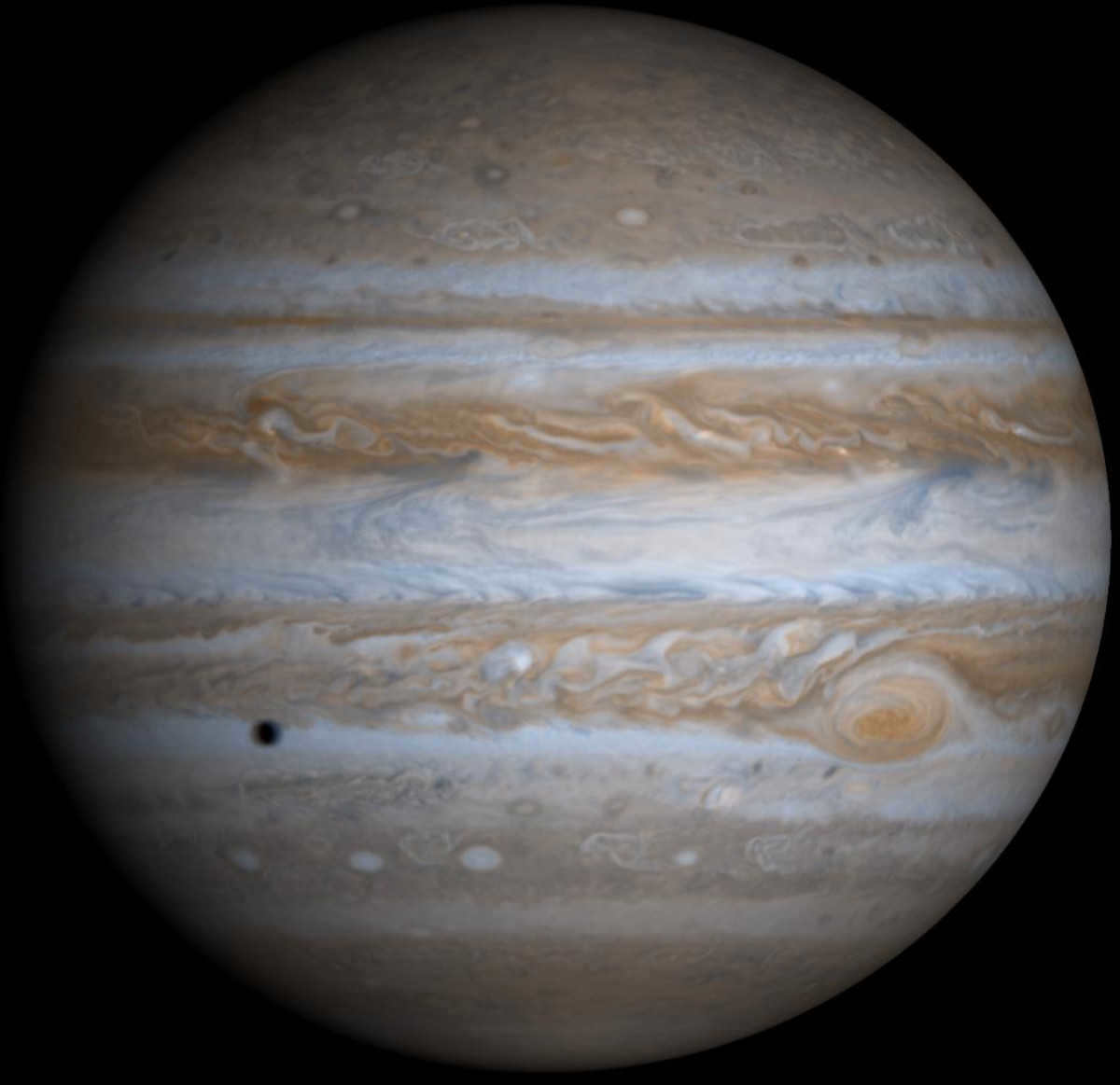
JPL produced this image of Jupiter, which shows its true colors and demonstrates its impressive size and rapid rotation. The dark spot visible in the photo is actually the shadow cast by one of Jupiter’s moons. The photograph was taken by the Cassini spacecraft, a project in collaboration between NASA and the Jet Propulsion Laboratory.
Cassini captures stunning images of Jupiter while en route to Mars
NASA’s Cassini spacecraft has recently snapped some breathtaking photos of the magnificent gas giant as it continues its journey towards Saturn. Here is another incredible shot of Jupiter taken by Cassini, showcasing even more intricate details, and an even closer view.
With a diameter of 88,846 miles, Jupiter is truly a colossal planet. However, what’s truly fascinating is its relatively short day, which lasts less than 10 Earth hours. Due to its rapid rotation, Jupiter appears slightly oblong, bulging outwards. In terms of proportions, Jupiter measures 11.2 Earth widths, but only 10.5 Earth heights, resulting in a difference of approximately 5,764 miles.
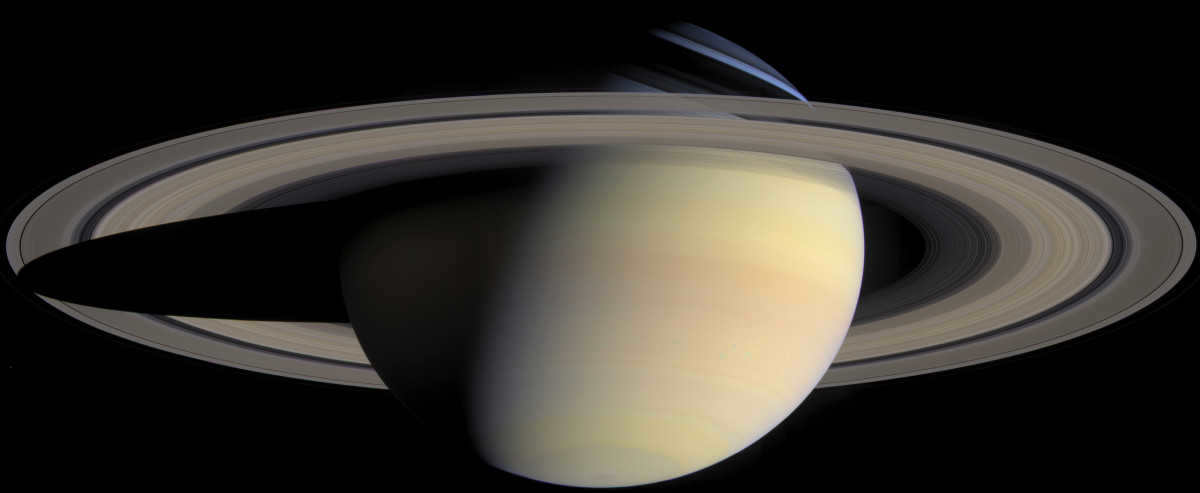
A stunning representation of Saturn comprised of 126 individual images captured by the Cassini spacecraft on the same day.
Credit: NASA / Jet Propulsion Laboratory / Space Science Institute
The Legacy of Cassini: 2004-2015
The Cassini mission has provided over a decade’s worth of extraordinary scientific discoveries, including the exploration of Titan’s intricate river systems and vast oceans, the revelation of Enceladus’ colossal geysers, and the iconic photograph of Earth framed by Saturn’s majestic rings. Additionally, Cassini achieved the historic feat of deploying the first probe to capture images of Titan’s surface!
Upon closer examination of this image, one may observe subtle blue-gray patches representing thunderclouds, particularly in the high-resolution version. In 2011, Saturn experienced severe thunderstorms in this region of the northern hemisphere.
Similar to Jupiter, Saturn exhibits a flattened shape due to its rapid rotation, resulting in a day length of 10.5 Earth hours within its 24-hour day.
The Voyager 2 spacecraft in 1986 captured images of Uranus, which have been slightly color-corrected.
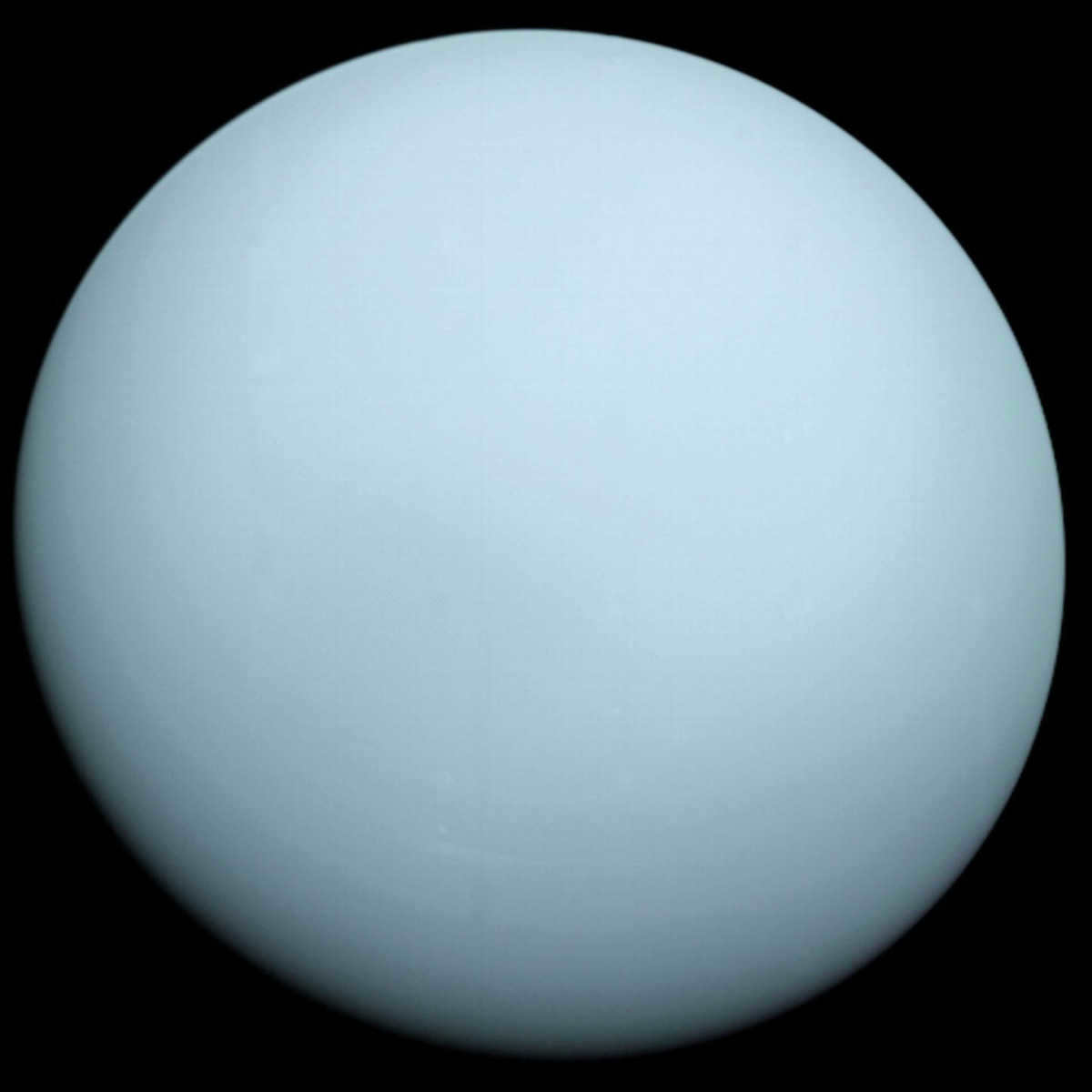
By combining the highest resolution image of Uranus captured by Voyager 2 with the hue extracted from the Hubble Telescope, I have created a unique and mesmerizing visual representation of this enigmatic planet.
Credits: Voyager 2 spacecraft – NASA / Jet Propulsion Laboratory-Caltech
Uranus: Unveiling its Hidden Charms
Isn’t it fascinating how serene Uranus appears? However, when observed in the infrared spectrum, one can discern the presence of faint smoke rings and delicate cloud formations enveloping the planet.
Creating this composite image required meticulous effort. Having previously worked with Voyager 2 images of Neptune, I was aware of their tendency to be slightly oversaturated, resulting in Uranus resembling a refreshing mint.
To address this issue, I superimposed a lower-resolution depiction of Uranus onto the “natural colors” portrayal of Uranus and adopted the hue. Dr. Erich Karkoschka is a prominent authority on the atmospheres of Neptune and Uranus, so I have a slightly higher level of confidence in his interpretation of the “natural colors”. Additionally, I compared my outcome with Björn Jonsson’s image processing, and the color is incredibly similar.
ETA: Furthermore, here is a small yet captivating photograph of Uranus emerging from behind Saturn’s rings, captured by the Cassini spacecraft using natural colors.
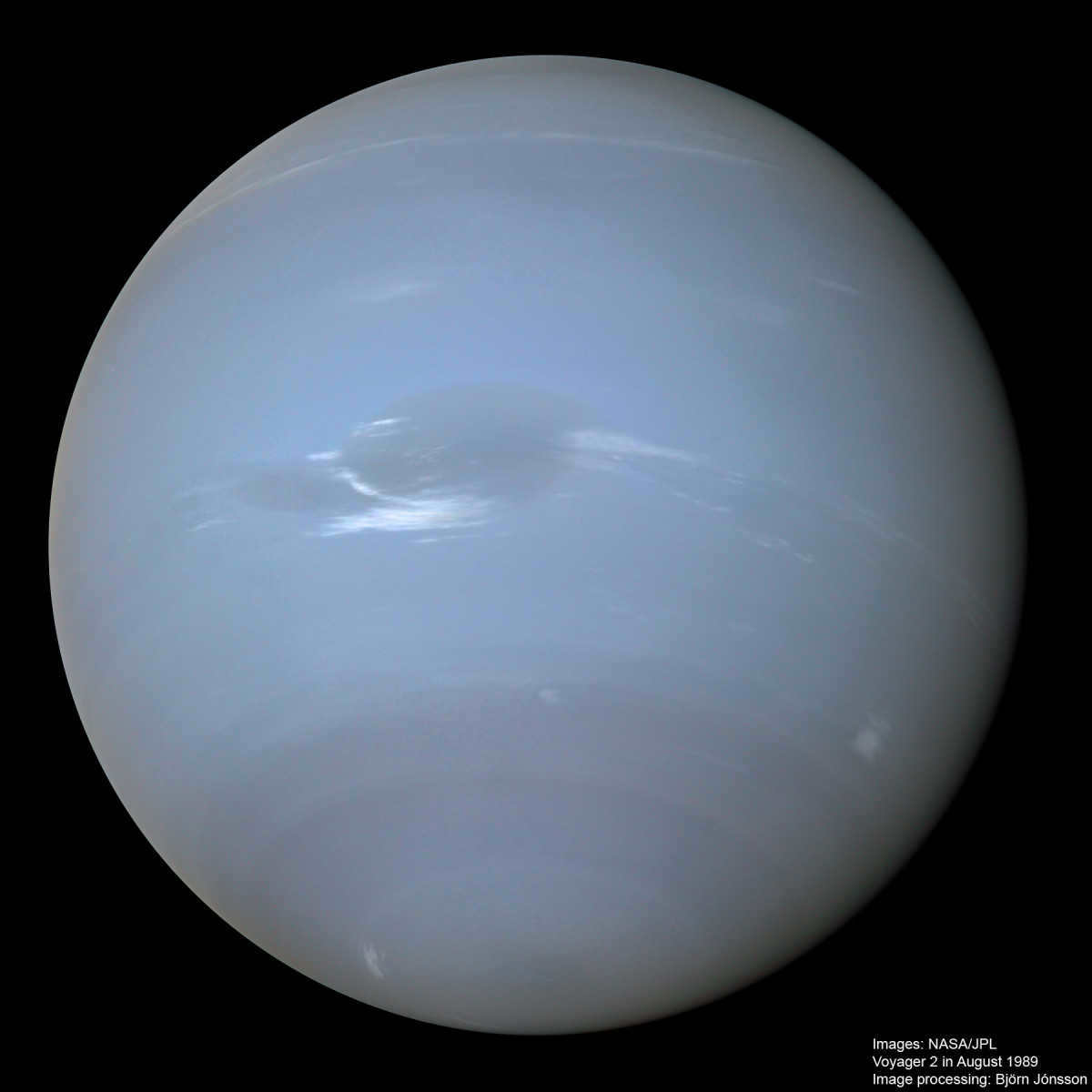
Neptune’s atmosphere is composed of hydrogen, helium, and methane, which are swirling around the planet at a staggering speed of 1300 mph / 2100 km/h. © Bjorn Jonsson, (CC BY-NC-SA 3.0)
"Voyager 2, image processing © Bjorn Jonsson – NASA / Jet Propulsion Laboratory
Neptune: The Enchanting Blue Vortex
The photographs captured by Voyager 2 of Neptune often appear oversaturated, giving the planet a striking resemblance to lapis lazuli. It possesses a captivating blue hue, although not as intensely saturated.
Upon reaching out to Dr. Emily Lakdawalla, a planetologist and blogger for the Planetary Report, she suggested that Bjorn Jonsson handle the image processing of Neptune. In this post, you can find an explanation of how he combined the black and white data from Voyager 2 with low-resolution color data to produce the stunning mosaic showcased above.
On July 13, 2015, the New Horizons spacecraft encountered Pluto.
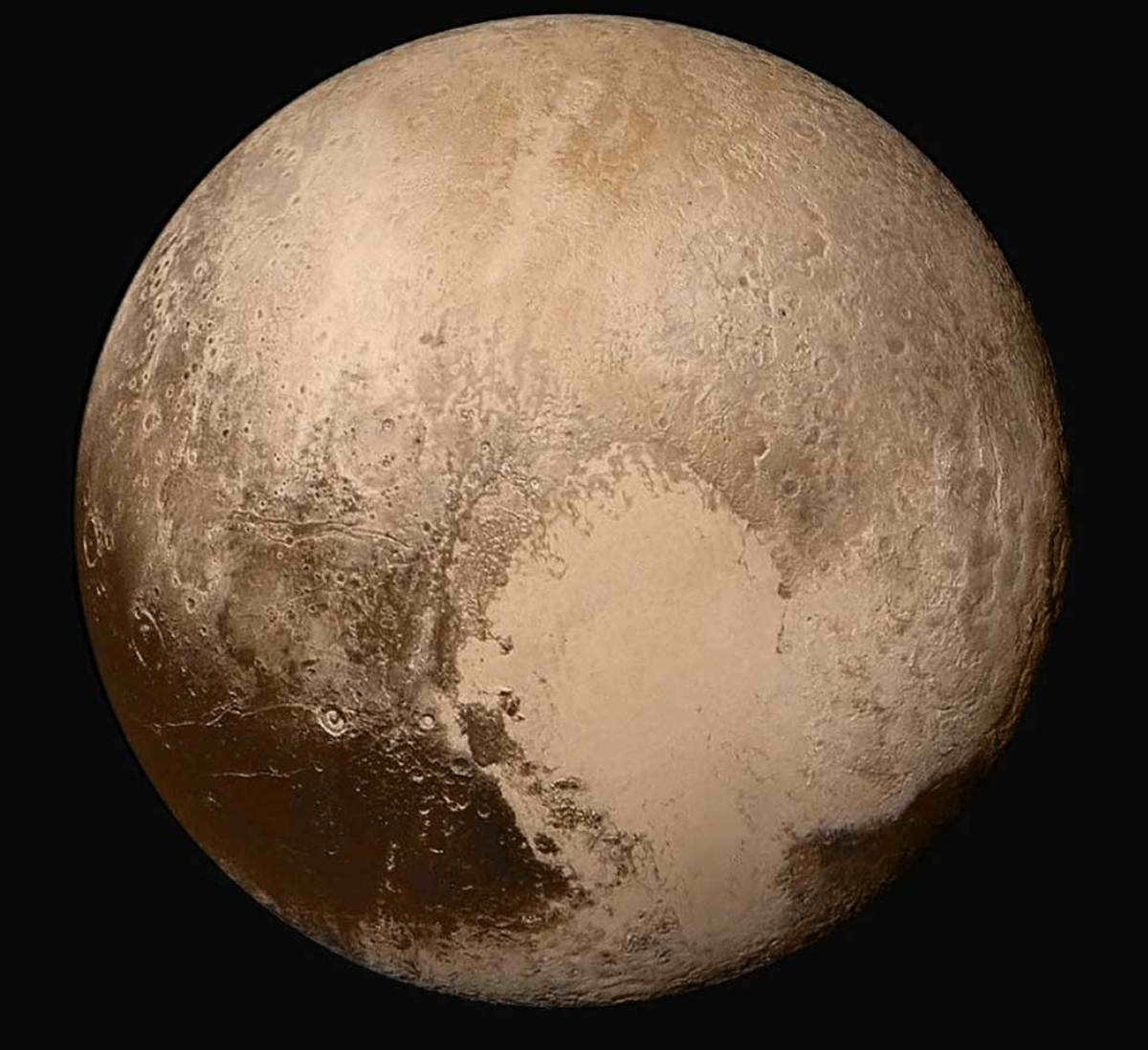
The color of Mercury, the planet, can be determined by using a combination of high-resolution black and white images captured by the New Horizons camera and low-resolution color data. The New Horizons spacecraft, which was built 30 years after Voyager, has improved optics that allow it to capture clear images even in low light conditions, enabling it to observe objects even when they are 3 billion miles away from the sun.
The unique perspective provided by New Horizons reveals that, similar to Uranus, Pluto also rotates by tilting on its side. In the photo, the yellowish area at the top represents Pluto’s north pole, which is slightly tilted towards us. This fascinating discovery adds to our understanding of the dynamics and characteristics of this distant celestial body.
Image credit: New Horizons – NASA / JHUAPL / SWRI
My personal depiction of the solar system (excluding: Eris, Makemake, Haumea, and other celestial bodies)
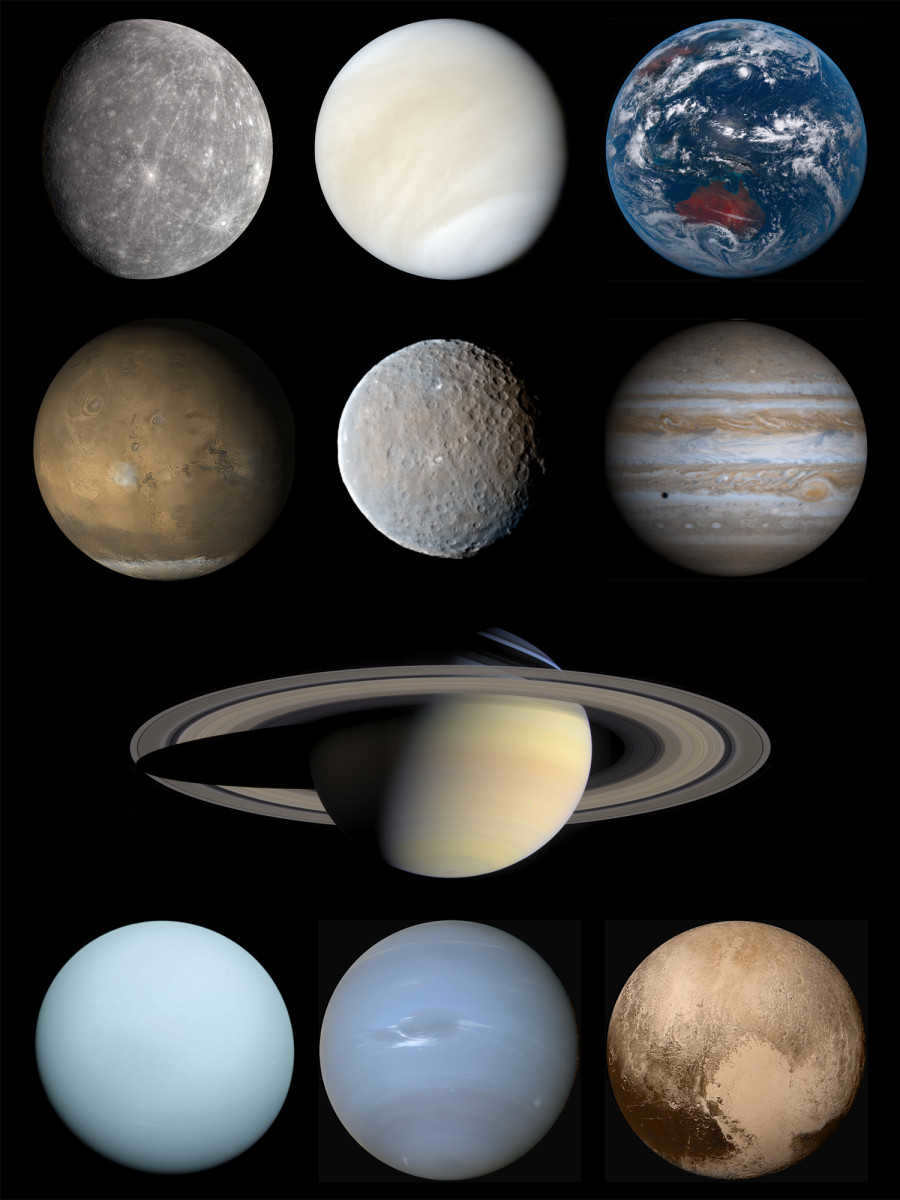
Note: Ceres is estimated to be a certain color. To get an idea of its color, I superimposed a Hubble photo on it, but we still don’t have a color photograph showing the globe from the Dawn mission to Ceres.
I bet, we already know the winner of this competition…
Solar System HD (Thomas Pickett, 2011, prior to New Horizons)
Links we recommend
- Discover the Color of the Solar System with Donald E. Davis: Donald E. Davis, a NASA scientist, has extensive knowledge in space probe optics. While my focus was on the colors, he also fine-tunes the albedo, which is the reflectivity of surfaces. This aspect may have been overlooked by my other sources.
- Planetarium Madison’s Quest for Planets in Natural Colors: The Planetarium Madison is also facing difficulties in finding photographs of planets in their natural colors. It seems I am not alone in this struggle. They are opting for a redder portrayal of Mars.
- Dr. Emily Lakdawalla’s Artwork: “Not Planets”: Inspired by Gildea’s “Planetary Suite,” my collage was created. However, we now know that there are more or fewer than nine planets, depending on how one defines “planet.” I am not concerned with definitions. What matters to me is raising awareness about Pluto’s celestial neighbors.
© 2015 Ellen
The rover is going to test its self-driving capabilities as it embarks on a series of sprints to its next sampling location.
This enhanced-color mosaic of a hill in Jezero Crater was created using Perseverance’s Mastcam-Z camera system, which consists of multiple images.
A recent study has discovered higher-frequency X-rays and explains why they were not detected by a previous mission 30 years ago.
NASA’s Parker Solar Probe has captured its first visible light images of the surface of Venus from space.
A team of researchers is using two NASA planes to track storms across parts of the U.S., aiming to better understand the inner workings of winter storms.
Using the Mars Reconnaissance Orbiter, researchers from Caltech have determined that surface water on Mars left salt minerals behind as recently as 2 billion years ago.
Scientists have revealed that the samples gathered by Curiosity contain a form of carbon that is linked to biological processes on Earth.
Members of the mission team have created an artistic representation of the panoramic view captured by Curiosity from the top of a mountain on Mars.
On October 13, 2021, NASA’s Lunar Reconnaissance Orbiter (LRO) spacecraft captured an image of Saturn using its onboard camera.
New discoveries made by the Juno spacecraft have provided a more comprehensive understanding of the vibrant atmospheric characteristics of Jupiter, as well as offering insights into what lies beneath its cloud cover.
In a recent paper, researchers have outlined the intricacies of the hydrological cycle in the now-dry lake located at Jezero Crater, revealing that it is more complex than previously believed.
By cleaning off a sufficient amount of dust from one of its solar panels, the lander has successfully kept its seismometer operational throughout the summer, enabling scientists to study three significant earthquakes.
Scientists have discovered evidence suggesting that Arabia Terra, an area on Mars, experienced numerous “super eruptions” over a span of 500 million years.
Perseverance has successfully gathered its initial set of rock samples, and scientists are already gaining fresh insights into the region.
Data received on September 1, 2021, indicates that NASA’s Perseverance rover has accomplished its objective of successfully drilling into a Mars rock.
This week, the rover will scrape a rock to determine if it can withstand its powerful drill, based on the analysis of scientists and engineers.
Addressing the complex issue of drought requires extensive data, which is collected by satellites from NASA and its partners.
There is speculation that approximately 5,000 years ago, a comet came within 23 million miles of the Sun, closer than the planet Mercury.
Additional Travel Destinations
Stay in Touch
Exploring the Solar System
Discovering Planets
Known Planets
Smaller Dwarf Planets
Speculative Worlds
Exploring Moons
Organized by Destination
Asteroids, Comets & Meteors
Sorted by Type
More Information
- Latest News
- Skywatching Tips from NASA
- Helpful Resources
- Raw Images
- Notable Individuals
- Mission Details
- For Young Space Enthusiasts
- Interactive Experiences
- Basics of Space Travel
- Solar System Ambassadors
- Resource Packages
- NASA HEAT Program
This website is managed by the Planetary Science Communications team at NASA’s Jet Propulsion Laboratory on behalf of NASA’s Science Mission Directorate.





